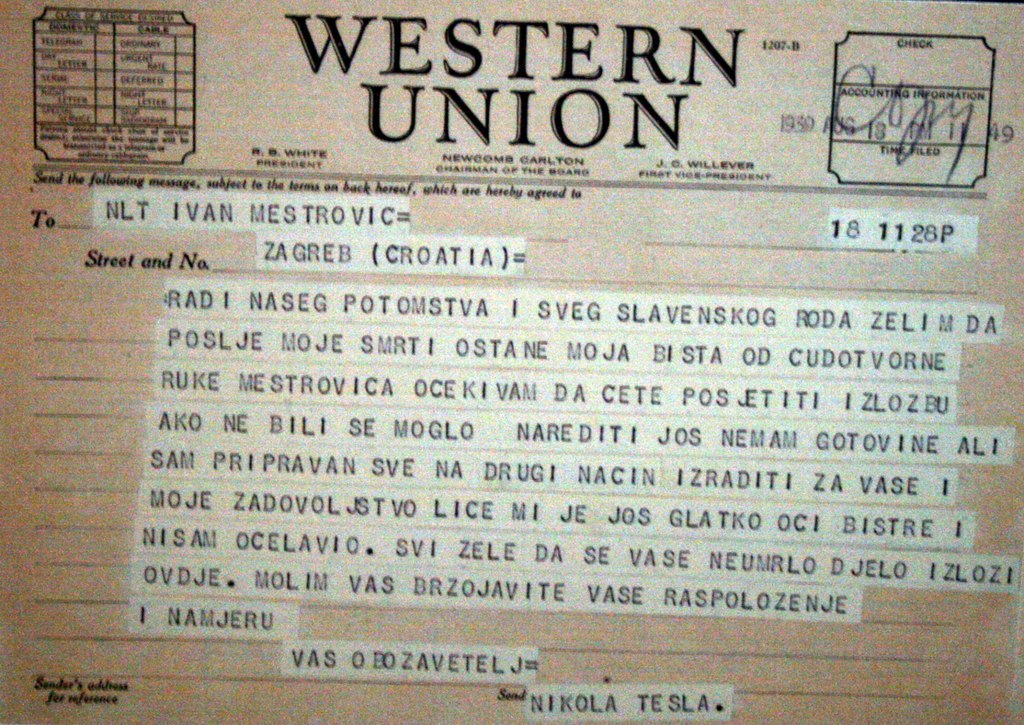Croatian Singer Ines Trickovic Will Hold Voice Workshop in California
March 18, 2022 - Renowned Croatian jazz singer Ines Trickovic will hold a voice workshop in Santa Monica, California called ''Liberate your Voice''. In the workshop, the participants will learn along Ines to use their voice to express themselves freely through singing.
Julia Quena Kavi, a famous holistic life coach presents “Take control of your voice to take control of your life” by Ines Trickovic.
This workshop is designed for singing amateurs and enthusiasts with no prior training. It is 4 hours in duration and includes practical hands-on breathing and singing exercises that train your diaphragm, lungs, and vocal cords. The ''Liberate your Voice'' workshop will help you open up, speak and sing freely, release yourself from fear and inner criticism. At the end of the process, you will be empowered and confident as you learn to take control of your voice and master your life.
Ines Trickovic enjoys a very rare kind of success. With no formal training, she managed, not only to find her unique voice but to become a professional jazz singer and tour some of the most interesting corners of the planet. From the upscale venues of Hong Kong to Carnegie Hall in New York City, she has been wowing audiences for more than two decades. Her rich international career has seen her taking center stage in over 3000 concerts. Aside from this, she is a respected voice coach and voice therapist.
Take this opportunity to learn directly from her as shares some of her skills and insights.
For this workshop, Ines will be joined by Julia Quena Kavi, the award-winning professional opera singer, and vocalist. It was at the invitation of this famous holistic vocal coach, retreat facilitator, and spiritual coach that Ines decided to bring this workshop to California in the first place.
The workshop will take place on Thursday, March 31, from 12:30 pm to 4:30 pm, at Power Yoga East, 522 Santa Monica Boulevard in Santa Monica. The price of the tickets for the workshop is $90 and you can purchase them HERE.
For more, check out our lifestyle section.
Maksimilijan Vanka Gallery to Reopen in the Artist's Villa in Korčula
March 14th, 2022 - The entire Memorial Collection of Maksimilijan Vanka will be restored and moved from Zagreb back into its home on Korčula
As announced by Korčula Mayor Nika Silić Maroević, the lovely villa in Korčula town that was once owned by Croatian artist Maksimilijan Vanka is finally to be restored.
In 1935, Vanka moved to the US where he's best remembered for painting the Millvale Murals in the St. Nicholas Croatian Catholic Church. The renowned painter and sculptor used to spend summers on Korčula island, where he founded an art colony and socialised with his fellow artists.
His former holiday home is known as one of the most beautiful villas in town, located near the monastery of St. Nicholas, reports Dubrovački vjesnik.
After Vanka’s death in 1963, his widow Margaret Stetten Vanka and daughter Peggy Vanka Brasko donated two houses in Korčula to the Croatian Academy of Sciences and Arts (HAZU), along with 47 of Vanka’s artworks created in Korčula and the US.
The other, smaller villa donated to the HAZU by the Vanka family had a different fate. In the early 90s, it was transferred into private ownership and has been sold since.
The bigger villa, now to be restored, used to house the Memorial Collection of Maksimilijan Vanka. Due to poor conditions in the villa, the art collection was moved to Zagreb and is currently kept at the Strossmayer Gallery of Old Masters.
Two years ago, it was announced that the entire collection will be restored, with funds secured by the Society of Maksilimijan Vanka’s Friends from the US. Once the restoration is completed, the artworks should be moved back to Korčula, but it’s not yet known when this is supposed to take place.
Renovation of the villa should have started two years ago when the president of the Croatian Academy of Sciences and Arts (HAZU) signed a cooperation agreement with the then Mayor of Korčula, providing for the renovation, reconstruction and adaptation of Villa Vanka and the restoration and return of Vanka's art collection to Korčula.
Unfortunately, the global pandemic began shortly after the agreement was signed, so the plans had to be put on hold for a while.
‘In the meantime, potential investors expressed certain interests that the HAZU approved as well, so we will amend the existing agreement a bit in order to further define certain details’, announced Mayor Silić Maroević.
Amendments to the agreement mainly relate to the catering business conducted in the villa, which proved not to be a good decision in the past, according to the mayor. Ten years ago, the gallery was renovated, but not in a dignified manner, she pointed out, and part of the gallery was leased by a catering business, which isn’t acceptable to the City of Korčula or the HAZU.
Villa Vanka will now be renovated and used exclusively as a gallery, the only exception being the lower part of the warehouse which might eventually be leased out for service activities. This will be defined by the new agreement, said Mayor Silić Maroević.
Although Korčula boasts incredible cultural heritage and numerous acclaimed artists, the town sorely lacks gallery spaces. This is yet another reason why everyone’s looking forward to the renovation of Villa Vanka, with the new gallery seen as a crucial venue for the cultural life in Korčula.
Rising Star: TCN Meets Croatia's Eurovision 2022 Candidate Mia Dimšić
February 28, 2022 - TCN meets Croatia's Eurovision Song Contest candidate Mia Dimšić to gain deeper insight into her experience as a musician and lyricist before she takes the stage in Turin this May.
With Eurovision 2022 fast approaching, there’s a lot to be excited about. After winning the Dora song contest with her new single “Guilty Pleasure”, singer/songwriter Mia Dimšić is gathering attention from fans across Croatia, Europe, and beyond.
The Osijek-born songstress was first discovered in 2014 when tamburitza band Džentlmeni invited her to join them on a tour through Canada and the U.S., singing for the Croatian diaspora across North America. Dimšić subsequently released her first single “Budi mi blizu” in 2015. Since, she has released three Croatian language albums.
When did you begin singing and why did you choose to pursue a career in music?
The beginning of my professional career happened quite by accident. Me touring, meeting my manager. Nearing the end of my college I just knew I didn’t want to do that for the rest of my life because I was into music. So, I would say the beginning of my professional career was in 2015 when I released my first single. But also, of course, my whole life revolved around singing and music. I don’t really think music is limited to professional musicians. There are a lot of people who just live music 24/7 but they don’t earn their income from it.
Do you come from an artistic family?
Well, my dad also studied guitar in musical school. So, he has a basic musical education, I would say. He also had a band before I was born but he never played professionally. It was more like just a side job along with his day job. I was actually the first in my big circle of family and friends to really decide to be a professional singer/songwriter. So, I never had people around me who were songwriters. I met my manager who also writes songs in 2014; someone just next to me who I can really ask what makes a good song. When I write something down I ask is it good or not? How can I tell if it's good or not? I didn’t grow up around it, but I maybe prefer it that way because I developed my own theories about it and the principles and then I kind of got into that world later.
What kind of singer would you classify yourself as?
I think I’m a singer-songwriter first and foremost because I’m pretty sure I would never have been a success if I didn’t write my own songs. Because I think, for me the most important moment was this storyteller moment. I am a huge fan of Taylor Swift and the way she just tells stories through lyrics is something that never fails to amaze me. So, whether it be the happy romance story or just some sentence I heard along the way or something my friends told me about when I feel strongly about something the most therapeutic way to deal with it is just to sit down and write a song. That’s what I want to do. I want to tell stories through music.
Your song “Guilty Pleasure” won the Dora singing competition, congratulations! What skills did you learn from the competition that you think will help you during Eurovision as well as in your future career?
Well, there were so many interesting lessons. First of all, just standing on a stage like that is not an everyday opportunity in such a small market as the Croatian market. So, for all of us young singers there, it was such a fantastic experience in terms of audio production, visual production and just getting used to the big stage. I think that that will be very useful in touring. Also, I bonded with a lot of new people. That was the most amazing part, and I can’t wait to do the same when touring and meeting some international stars I’ve been watching throughout the years.
Also, one of the big life lessons Dora brought was just to enjoy the moment. Because all of us contestants just wanted to win. It can get pretty competitive, and it can get pretty stressful you’re under a lot of media attention. So, I said to myself, just being there among the 14 contestants is already me winning, just winning life because I’m learning something new. I’m gaining some new experiences. And if I manage to get that mindset in Turin, I know that everything is going to be fine because I think problems arise when people are very stiff and are obsessing about something. Music really should be about living in the present moment. So, I think if I come there and manage to just enjoy every day, every rehearsal, every encounter, then the results are going to be good as well.
What was your inspiration behind “Guilty Pleasure”? Do you have a personal story underlying the lyrics?
Yes, absolutely. It is just the most fun and the best experience ever when you write something specific about your experience and then it goes out into the world and people somehow connect to it. In this case, I had a dream five nights in a row, as the first lines say. It was very literal. I dreamt about someone I felt I wasn’t supposed to be dreaming about. And since I was a teenager since I started falling in love and stuff like that, I’ve always been obsessed with the idea of ‘how do you really decide on just one person?’ You know you get married to that person and that’s it. How do you know if they are right for you? How did women know in the 19th century? When practically their whole life depended on them marrying the right person or it could be a disaster if they married the wrong person?
I am just so fascinated by that question. Is monogamy really the path humanity should be choosing or are we just raised that way? We’re not looking for any other way. ‘Guilty Pleasure’ was actually a song about that. The ending of the song and also the visual choreography that we put with a song where I have a male dancer who represents that fantasy of mine. I want to run away with him, but also I’m not sure because I have a safe harbor. I have someone else in my life. What if it’s just an illusion? What if I am romanticizing it? And then in the end there’s an instance where we almost kiss, but the viewer is not sure if we do, or we don’t. So, actually, I’m not sure either. The ending of the song is my question. Should I run away with you, or should I just let it be? It’s a very light catchy pop song. But what inspired me to write it are very tricky questions that are really messy.
Describe your creative process. Where does your inspiration come from when you write your songs?
For me, it always goes music first and then lyrics. I am very obsessed with lyrics having to rhyme and every verse has to be symmetrical. I am very much a lover of symmetrical lines, and I am trying to use pretty words that sound nice when you sing them. I am careful and pay a lot of attention to that.
What musicians do you admire most and why?
I discovered Taylor Swift when I was 16 years old. Back then she just released her first international album “Fearless”. And I heard Love Story and I was in the exact same situation. I wanted to meet with a boy and my parents wouldn’t let me. He lived on the other side of Croatia. So, for me just listening to that song felt like OMG Taylor Swift read through my diary. That’s the only possible explanation for her incredible insight into our souls, in our lives. Throughout the years whenever I had a certain situation, I just connected to her songs. Literally today, I’m 29 years old and if you tell me any of her songs from any of her albums, I will tell you what was happening to me when I first heard it. I guess it’s like what you said, we humans only exist to share the same kind of emotions through different stories with each other. And I think the most amazing part of her as a songwriter is that she can take something very complex into two lines of a song. And you’ll just hear it and maybe it’s something completely different from what you’ve ever experienced but you will feel like you’ve been there. That for me is art. Putting something we all know so well but don’t how to verbalize, for me, that’s a true artist.
Throughout Eurovision history, singers choose the language of a song for different reasons. Most of your music up to this point has been in Croatian. Why did you choose to write an English song this time?
That’s a really good question. I actually spent the entirety of 2021 writing songs in English only because I entered a phase of wanting to start the English chapter of my journey. I’ve always wanted that since my first Croatian song. I thought, ok maybe I should first work in the domestic field and with time and with the experience I can start writing songs in English too. Actually, my first motive for Dora, in the first place if I applied because I wanted to, if I hypothetically got the chance to go to Eurovision, I want to present my music to as many non-Croatian speaking people as I can. I think Eurovision is a great opportunity for that. It’s definitely an incredible festival. But, for me, it should not just be the end. It should be the first stage where I get such an incredible experience and audience. But I want to keep on releasing English music and going in that direction.
How does it feel to be representing Croatia on such an international stage?
It’s incredible. I am very proud of my team. We’ve worked so hard for this. I am very excited. I can’t wait to go to Turin. Of course, there is always some kind of pressure because everyone feels very intensely about Eurovision and everyone has their own opinion. Whoever wins in Croatia will always face a lot of backlashes as well. Almost every year there are stories about who won. But I think this part as well will also make me a stronger person and stronger artist. I just think it is a huge honor and a huge privilege.
What are your aspirations going into the European Song Contest? Obviously, not all countries have submitted their entries, but do you see any clear front runners who will make for a tough competition?
I think Italy will do really well this year. Everyone is loving the song and I love the song as well. I think Eurovision trends change so rapidly every year that it’s so hard to say what will catch peoples’ attention this year. I think it is going to be a wonderful Eurovision this year. There are so many interesting songs and there is a huge variety of different genres of music.
Going forward, what are your plans beyond Eurovision? What are your goals for your career?
My goals for my career are currently just doing everything I can to present ‘Guilty Pleasure’ to as many people not just around Europe but around the world. Next week, I am also finally filming a music video which will be filmed in the region where I am from. So, it’ll showcase all its beauty. I am hoping to also have a couple of other English songs ready the moment I reach Turin. I can just find people who like it and connect with the producers. I think networking is the most valuable thing we can get from Eurovision. After Eurovision, I don’t want to just come home and forget it happened and continue releasing the normal songs that I’ve got planned out. I also want it to be a starting point for new collaborations. I hope this plan will work. I really really want it to work. I’ll do my best. I just hope when people remember me, they’re going to remember the song or they are going to remember that I was there that year. That’s all I’m hoping for right now.
For more, check out our lifestyle section.
Tara Stanić Will Exhibit Her Artwork at the Lauba Gallery on February 10th
February 9, 2022 - Lauba's project cycle "Send on" continues with exhibitions of works by young authors, and this time hosts the artist Tara Stanić. The opening of the exhibition ''Only Dreams'' will take place on Thursday, February 10, at 19:00.
The exhibition cycle "Send on" of the House for People and Art Lauba, in which young authors have the opportunity to present themselves to the public, continues on Thursday, February 10, with the exhibition "Only Dreams" by Tara Stanić, reports Večernji List.
''In these works, I transfer my own dreams into reality by focusing on the atmosphere and emotion I had at that moment'', mentioned Stanić in the announcement of the exhibition.
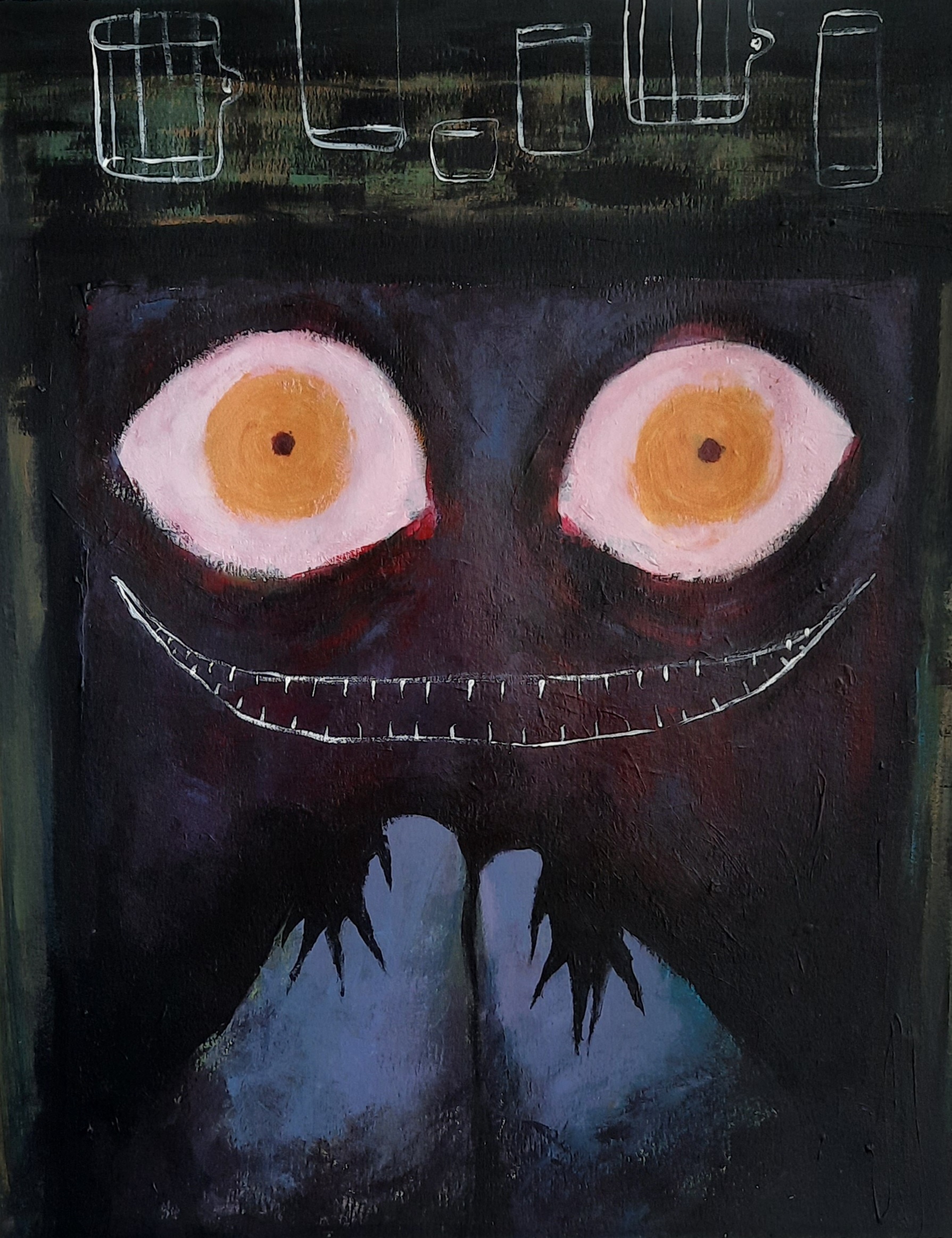
Tara Stanić/www.lauba.hr
''I wake up from sleep with an intense feeling that accompanies me through the morning and day. In the process of waking up, I remember situations, dialogues, and emotions from dreams, and sometimes I try to discern what they were with difficulty. To prevent dreams from fading from memory, I write them down. However, certain dreams are etched in my memory for years. I am fascinated by the way dreams intertwine with each other, and how detailed and vivid they are in their unreality. I draw inspiration from their apparent incoherence, meaning, my own thoughts, dialogue, and their bizarreness. In these works, I translate my own dreams into reality by focusing on the atmosphere and emotion I had at the time'', says Stanić about her work.
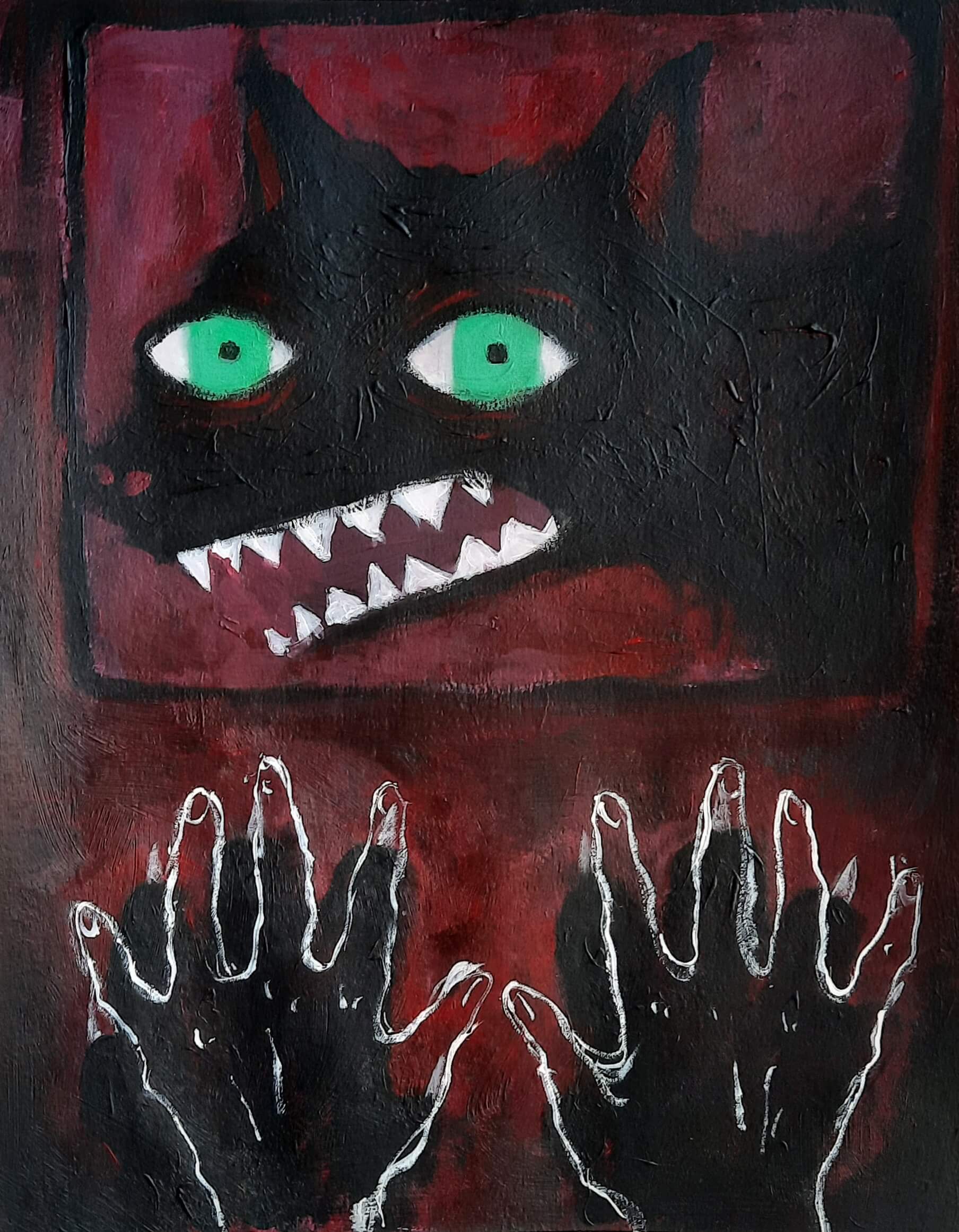
Tara Stanić/www.lauba.hr
Tara Stanić was born in Zagreb in 1998 and graduated from the School of Applied Arts and Design in Zagreb. She is a student at the Academy of Fine Arts in Zagreb at the Department of Fine Arts, majoring in graphics in the class of Professor Igor Čabraja (second year of graduate studies). Through graphics, illustration, comics, and painting, she explores the grotesque, the fantastic, alienation, and loneliness. Using narration, imaginary monsters and the dream realm combine the unusual, the creepy, and the witty. She has participated in group exhibitions in Zagreb (ALU, 2018-21) and Antwerp (Royal Academy of Fine Arts 2019, TICK TACK Gallery, 2020) where she has been part of the Erasmus + program (2019).
You can find in the map below the address and location of the House for People and Art Lauba.
Admission to the exhibition is free, and it is open Monday through Saturday from 9 a.m. to 10 p.m, and all prescribed epidemiological measures will be followed.
You can find more information about Tara's event in the official Facebook event.
For more, check out our lifestyle section.
‘Your Fan, Nikola Tesla’: When the Great Inventor Met Ivan Meštrović
January 16th 2022 - Ivan Meštrović, a master sculptor and one of the most renowned Croatian artists of all time, died on this day in 1962. A lesser known fact about Meštrović is that he was friends with another famous figure from these parts, the great inventor Nikola Tesla. The two great men met in New York and maintained a decades-long friendship through correspondence
Ivan Meštrović, a master sculptor and one of the most renowned Croatian artists of all time, died on this day in 1962. Having gained United States citizenship a few years earlier, Meštrović passed away in the US, after an illustrious international career and numerous accolades won for his exceptional artistic work.
He was one of the rare Croatian artists to gain international recognition during his lifetime: he lived, worked, taught, and exhibited his art in Split, Paris, Rome, Belgrade, Zagreb, London, Geneva, Cannes, and all over the US. He was the first living artist to get a solo exhibition at the Metropolitan Museum in New York (1947).
Meštrović was the genius mind behind some of the most recognisable landmarks and monuments in Croatia. The Well of Life was installed in front of the Croatian National Theatre in Zagreb in 1912:
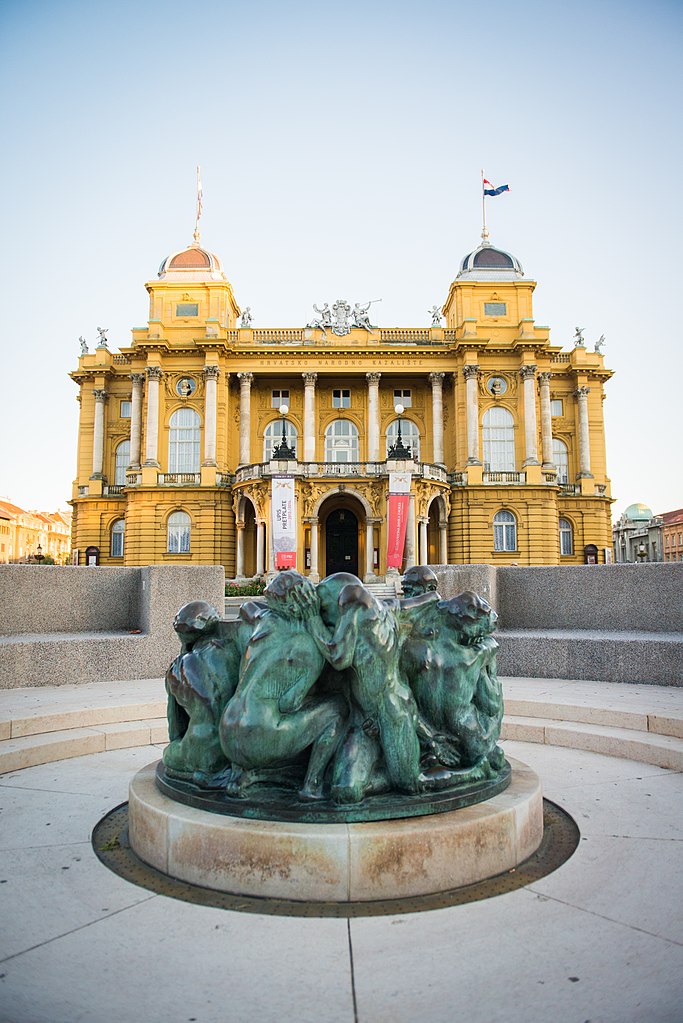
Another iconic landmark in Zagreb, the Home of Croatian Artists also known as Džamija (The Mosque), was designed by Meštrović and completed in 1938 - hence its other nickname, the Meštrović pavilion:
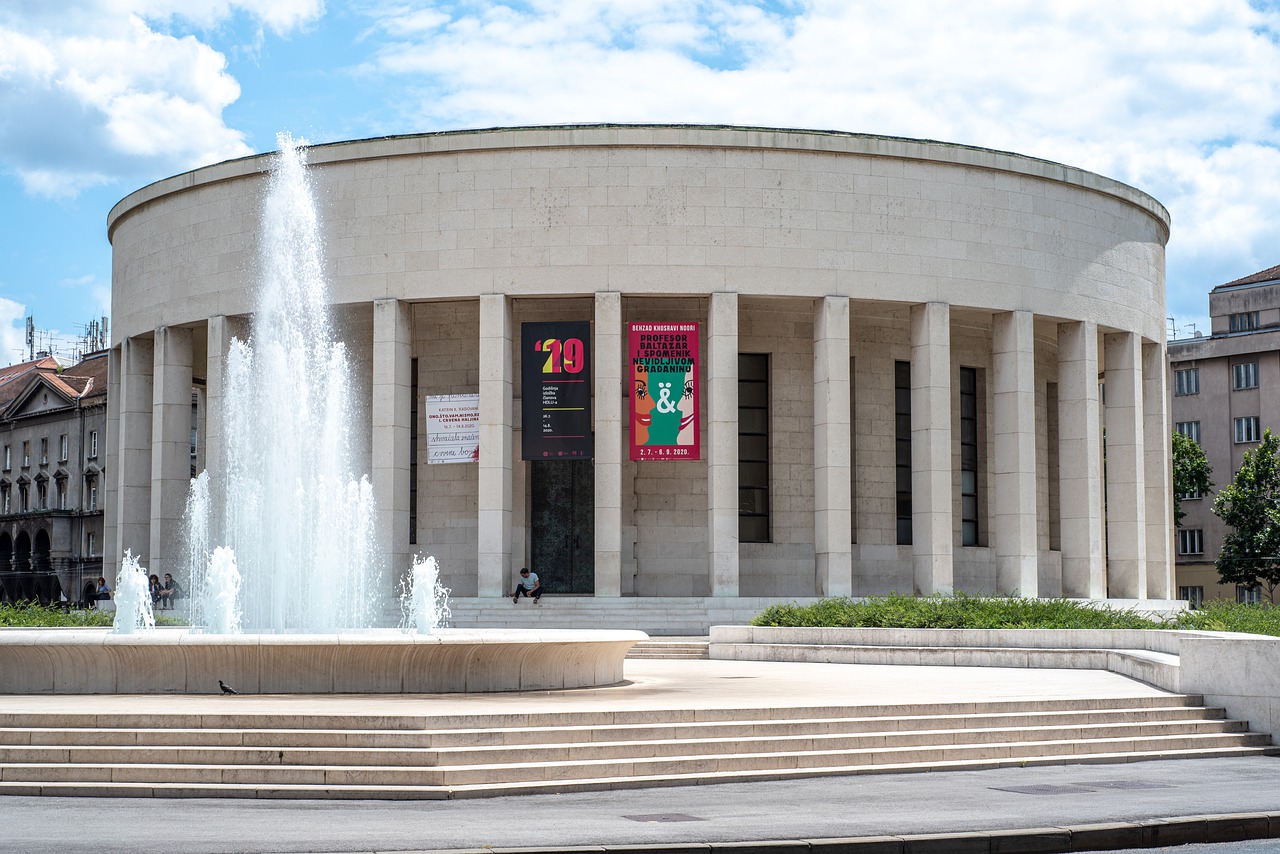
The gigantic statue of Gregory of Nin (Grgur Ninski) was initially installed at the Peristil in Split and later moved to its present location in front of the Golden Gate, where tourists in passing rub the saint’s big toe for luck.
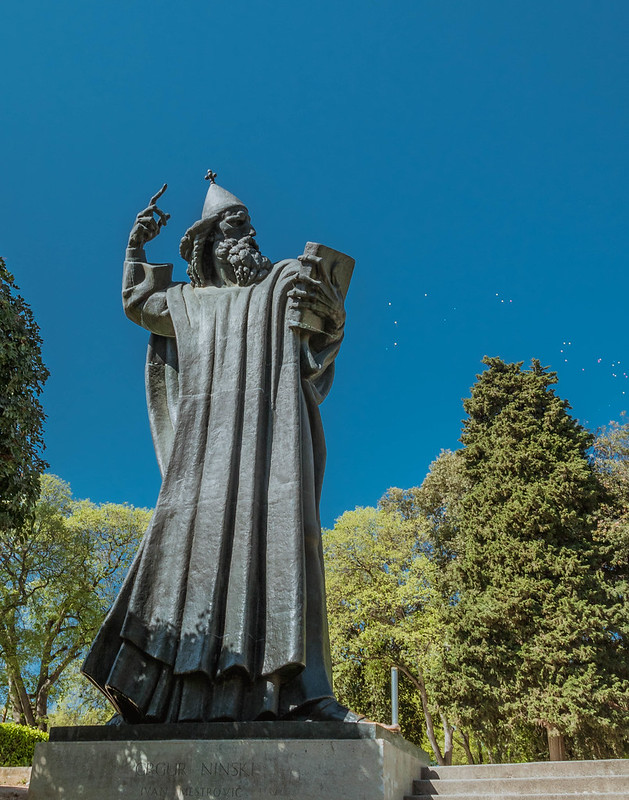
Photo: Statue of Gregorius of Nin in Split, Croatia by Marco Verch under Creative Commons 2.0
A lesser known fact about the master artist is that he was friends with another famous figure from these parts - the great inventor and scientist Nikola Tesla.
Tesla and Meštrović met in New York in 1924, where Meštrović had a solo exhibition at the Brooklyn Museum. Knowing that Tesla was also residing in New York at the time, the artist reached out with a letter expressing his wish to meet, sent from Hotel Gotham on December 13th:
Dear Mr Tesla, one of my main wishes in coming here was to meet you, wrote Meštrović.
Tesla wrote back from Hotel Marguery two days later:
Dear and great artist! I was happy to receive your letter and will be even more glad to meet you in person, as this has been a fervent wish of mine for many years now, replied Tesla with enthusiasm and proposed a meetup time. This was the beginning of a long friendship between the two men, each a master in his own field.
***
In the years that followed, Tesla saw other exhibitions of Meštrović’s work in the US, and wrote to the artist to express his admiration after an exhibition in Chicago in 1929.
They exchanged Christmas cards as well; they are kept at the Nikola Tesla Museum in Belgrade together with the letters and telegrams.
Another touching letter dates to November 12th, 1929 when Meštrović acted as a middleman for Matica srpska, a distinguished Serbian cultural-scientific institution that wanted to publish a biography of the great inventor.
I don’t know why they chose to go through me: either you weren’t replying to them, or they think you and I are closely acquainted making this a more convenient way [to reach you]. I would ask you to accommodate their request, not for their sake or mine, but for the sake of our nation, and most of all for the sake of younger generations who will see in you the most wonderful example of intellectual and moral virtue, urged Meštrović, going on to suggest that Tesla set a condition for his autobiography to be published in both the Latin and Cyrillic script.
***
In a telegram sent in 1939 Nikola Tesla expressed his wish for Meštrović to sculpt a bust of him.
Artists were known to frequently approach Tesla to ask if he would sit for a portrait, and he turned them all down - save for princess Vilma Lwoff-Parlaghy whose drawing was unfortunately lost. That he would personally reach out to Meštrović to commission a portrait bust only speaks to his respect for the master artist.
This is the telegram:
Sent from NYC to Zagreb on August 18th, 1939
The message reads,
For the sake of our descendants and all Slavic people I wish for a bust of me, made by the miraculous hand of Meštrović, to remain after my death. I don’t yet have cash, but I am willing to do everything to your satisfaction and mine by other means. My face is still smooth, my eyes bright, and I haven’t gone bald. Everyone wishes for your immortal work to be displayed here. Please send a telegram to state your opinion and intent. Your fan, Nikola Tesla.
Imagine having Nikola Tesla for a fan.
Meštrović promptly wrote back from Split:
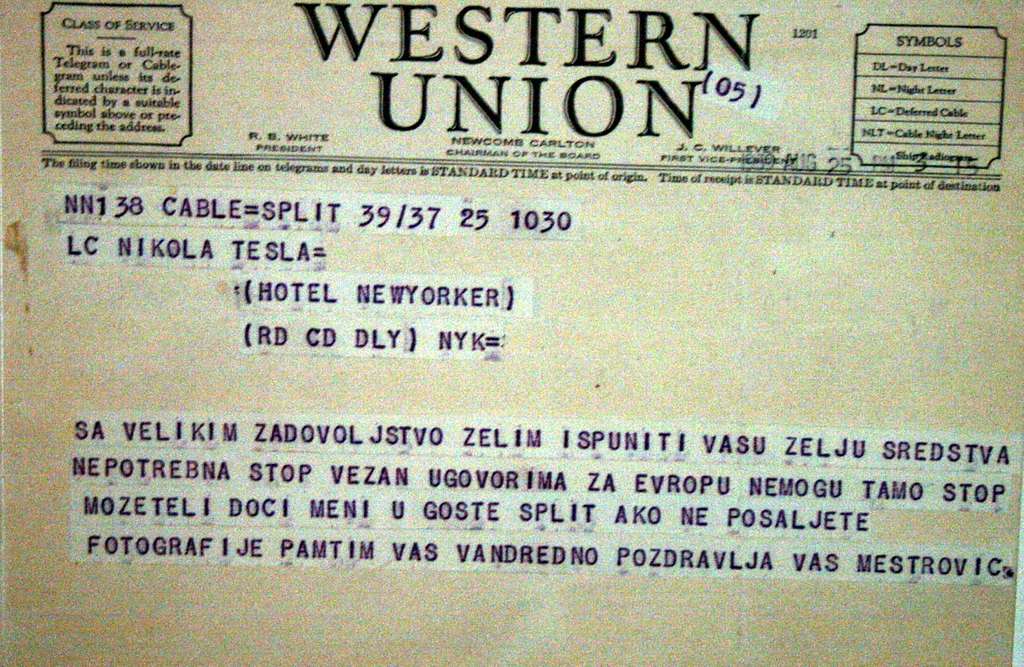
Sent from Split to NYC on August 25th, 1939
The telegram sent to Tesla reads,
It would be my great pleasure to fulfil your wish. Funds not necessary. I am bound by contracts in Europe, I can’t go there [USA]. Can you be my guest in Split, if you can’t, send some photos, I remember you vividly. Greetings from Meštrović.
Tesla was 83 years old at the time and was unable to travel that far, so he didn’t get a chance to pose for Meštrović before he died. The master sculptor kept his word regardless, creating two sculptures of Nikola Tesla in the years that followed.
One is a bronze bust whose original plaster model is displayed at the Croatian Academy of Sciences and Arts in Zagreb; bronze replicas are on display at the Nikola Tesla Museum in Belgrade and the Technical Museum in Vienna.
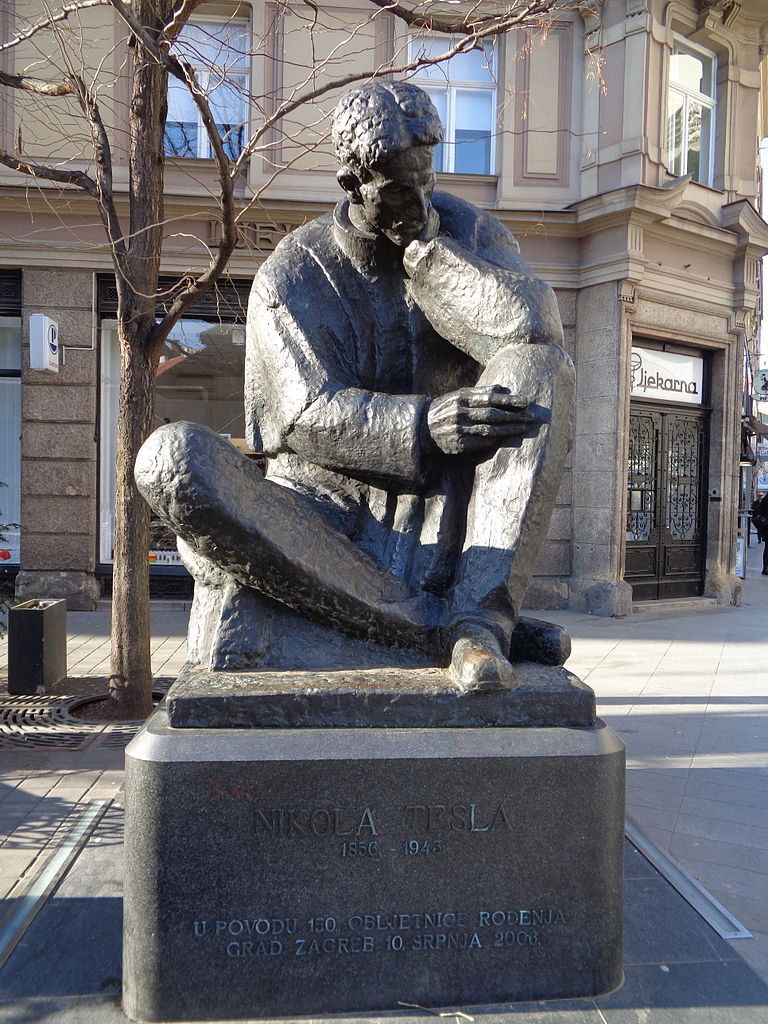
The other is the grand monument of Tesla displayed in Zagreb, shown on the photo above. It was originally installed in front of the Ruđer Bošković Institute in 1956, after Meštrović personally reached out to Croatian physicist Ivan Supek, the founder of the RB Institute. Supek recalled his correspondence with the artist for Jutarnji list/Tanja Rudež.
Meštrović was teaching at the University of Notre Dame in the US at the time, but kept close ties with his homeland. After an earlier sculpture of his, that of Croatian scientist Ruđer Bošković was installed in front of the Institute, he wrote to Supek saying he considered Tesla one of the greatest men from these parts. He said that he would gladly build Tesla a monument and asked for Supek’s opinion - naturally, he agreed, and the work was thus completed and displayed at the institute a year later.
In 2006, the monument was moved to its present location in the city centre, in the street named after Nikola Tesla.
To learn more about Ivan Meštrović and his legacy, visit the pages of Ivan Meštrović Museums / Muzeji Ivana Meštrovića.
Tisja Kljaković Braić Exhibition: Monument to a Living Person in Zagreb
September 28, 2021 - The Tisja Kljaković Braić exhibition titled "Monument to a Living Person" is honouring two decades of Braić's humorous, open and simple art. Authored by Frano Dulibić, the exhibition will be displayed at the Klovićevi Dvori Gallery until October 12.
The beautiful seventeenth-century building of Klovićevi Dvori in Zagreb's Upper Town (Gornji grad) is a piece of art itself. However, as this seventeenth century Jesuit monastery became one of the most known and respected art galleries in the whole country, you can expect plenty of art inside too.
If you have doubts (or you trust the statement completely and you want to enjoy some visual eye-candy), hop over to the venue at Jezuitski Trg 4 (Jesuit Square 4), for the monographic exhibition ''Monument to a Living Person'' that will be on until October 12.
The author of the exhibition is the art historian Dr. Frano Dulibić who gathered and displayed the work of the iconic Croatian painter Tisja Kraković Braić.
"Tisja Kljaković Braić has been part of the art scene for the last twenty years. After twenty years of dedicated work, there are many reasons to present the artist through a compilation of her best and most characteristic artwork. The exhibition at the Klovićevi Dvori Gallery will present her work from its initial phase of art brut painting, as well as her lyric, poetic paintings, sculptures, and drawings,'' Bulić said when explaining the motive of his display, as is written on Klovićevi Dvori's official website.
TCN readers may recall an interview with Kljaković Braić back in 2020 as she authored a book of caricatures on Dalmatian life entitled ''ONI'' (They).
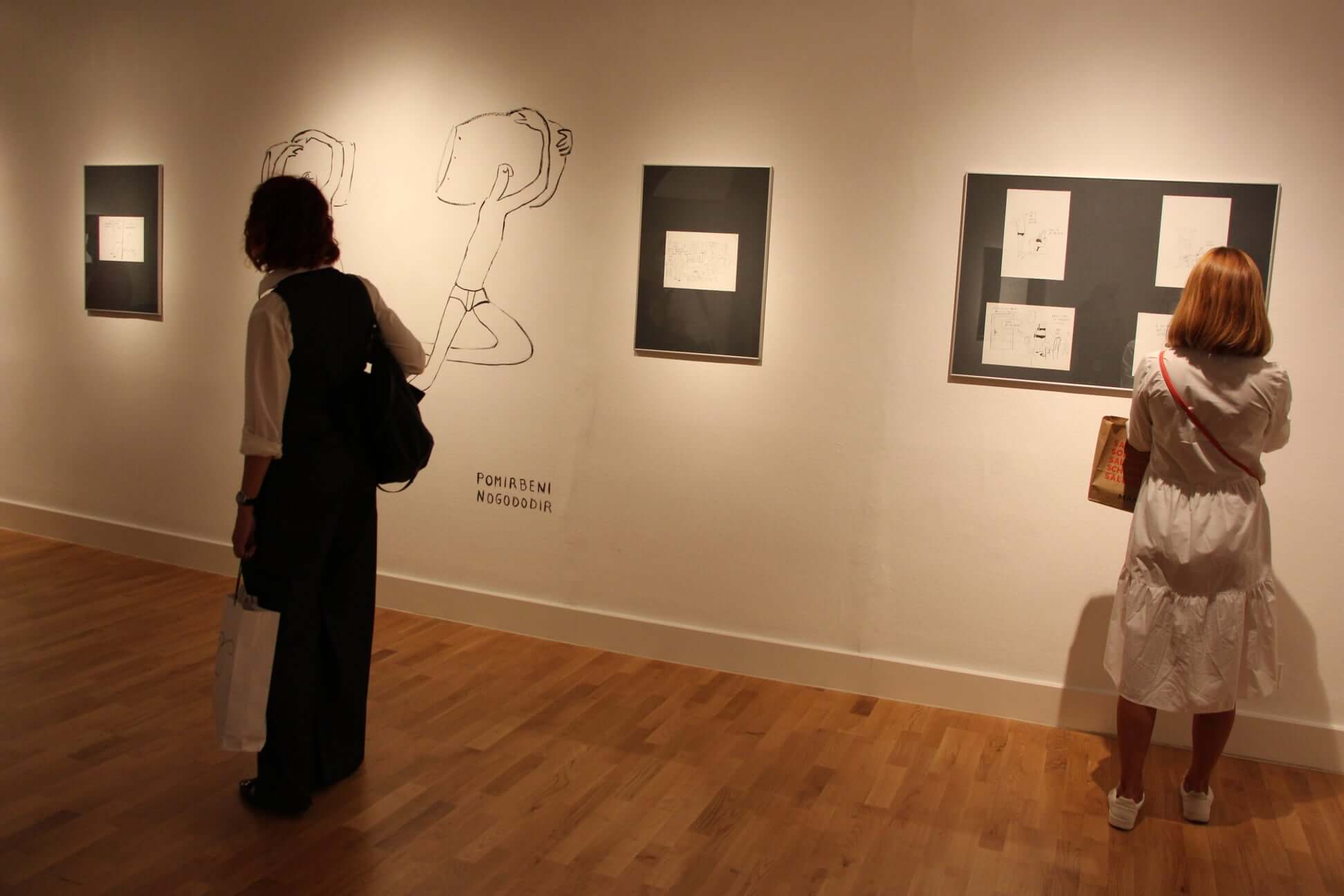
Scene from the "Monument to a Living Person" © Galerija Klovićevi dvori
''ONI'' are not left out in this exhibition either, and twenty years of Braić's work has made her art noted for its simple lines and shapes that gaze at you with openness, brazenness, honesty, and humor. It has been rated as primitive but certainly not in a bad way, quite on the contrary, due to effective ''waking up'' seen as a response from onlookers.
''With her primitivism, Tisja builds on many artistic paragons, from Paul Klee to Alberto Giacometti and Jean Dubuffet, who left significant marks on the art world. Nowadays, due to negative cultural implications, the art world seeks to avoid the term ''primitivism'' and appropriately replace it. At this point, the inevitable question arises: what is it in primitivist art forms that lures contemporary artists towards it, in a time of so many different art movements and ‘…isms’ passing us by?
The answer lies in an aspiration for disassociation from the frantic chase after something new and yet unseen, and an association with what is original, archetypal, primordial, and uncorrupted, that is, with the age when everything began,'' concludes Dulibić. Valentina Bach is the curator of this exhibition which is located on the first floor of Klovićevi Dvori. The gallery is open from Tuesday to Sunday, from 11:00 – 19:00.
Learn more about Croatian Art Galleries in Zagreb, Dalmatia, Istria & Slavonia on our TC page.
For more about art in Croatia, follow TCN's dedicated page.
Sisak Earthquake Photo Exhibition: Between Two Waitings by Miroslav Arbutina Arba
September 23, 2021 - The Sisak earthquake photo exhibition titled "Between Two Waitings" by Miroslav Arbutina Arba shows the horror of the 2020 earthquake in Sisak through documentary photos with an artistic touch.
The 6.3 magnitude earthquake on December 29 that severely damaged Petrinja and Sisak has traces which haven't faded as repairs and re-construction are still very much needed, and the Sisak earthquake photo exhibition will surely highlight the stark reality of post-earthquake life.
With Prime Minister Andrej Plenković promising earlier in September to accelerate post-earthquake reconstruction, a return to normal life in Sisak (architecture-wise) is yet to happen.
Meanwhile, as suffering is known to produce art, citizens of Zagreb (who also are not strangers to earthquakes) can closely observe the damage Sisak went through at Zagreb's Museum of Contemporary Art (MSU). In honour of European Heritage Day (September 18), MSU is hosting the Sisak City Museum by presenting the exhibition ''Between Two Waitings'' by famous Sisak photographer Miroslav Arbutina Arba. The exhibition opened on September 20, and it can be viewed until October 10.
The showcased photos which are part of the Sisak earthquake photo exhibition are a product of Arbutina being hired by the Culture Ministry to document the damage caused to cultural heritage for the purpose of evaluating the damage and producing documentation. As TCN reported earlier, the quake damage to cultural heritage in Central Croatia is estimated at €640 million.
''Arbutina gave a significant contribution to reconstruction efforts after the earthquake. His photos are, first and foremost, a witness to what happened, but with a clear artistic context. Photographing for the sake of documenting damage, he also found other motives that a regular observer does not notice. These motives, although they may exist in the documentary context, are nonetheless part of the same mosaic,'' wrote Vlatko Čakširan of the Sisak City Museum, who is also the curator for the exhibition on the MSU website.
''Those who haven't experienced this catastrophe probably think that losing your house is the worst thing, but it isn't. To me, the worse thing was expecting another new earthquake, that time of uncertainty between the two strikes,'' said Arbutina explaining the name of his exhibition.
Arbutina was born in Sisak on January 5, 1959. He took an interest in photography in the '80s when he got a Russian camera, a Lubitel, as a gift. Like many people in Sisak, he worked in a local ironware factory until he decided to try his hand at making a living solely from photography, taking industrial photos for brochures, etc.
During the Homeland War, he started working for various newspapers and other agencies. Enrolled in various projects (such as ''How Fish See Us'' where he took underwater photos of fish and plants in the Kupa river), his work received various rewards, and he moved from digital photography to experiment with the older technics of photography.
Learn more about Croatian Art Galleries in Zagreb, Dalmatia, Istria and Slavonia on our TC page.
For more about art in Croatia, follow TCN's dedicated page.
Močvara Handcraft Fair: Local Artists Showcasing DIY Work
September 22, 2021 - The Močvara Handcraft Fair organized by Udruga Avokado introduces the public to the handcrafted jewelry, cosmetics, and products of local artists while promoting an alternative, eco-friendly lifestyle.
Močvara nightclub in Zagreb, right on the Sava embankment (with Trnjanski Nasip bb being the address) is known for decades of supporting alternative art and culture, from music (punk-rock, metal, indie, and the most obscure electro-music extravagance), to theater, literature, circus, and more. As TCN wrote a couple of years ago, the venue hosted Žedno-Who pre-Party with a performance of an established Canadian musician Marc Demarco. In recent years Močvara opened more space to handcraft and Do-it-yourself culture (DIY).
In that spirit, the venue hosts a Handcraft Fair this Sunday, September 26, from noon to 6 pm, and the entrance is free of charge.
The event is part of the Močvara Living Room (Močvari Dnevni Boravak) program, happening mostly once to twice a month.
The fair will offer visitors handcraft jewelry, herbal food, drinks, clothes, toys, and cruelty-free cosmetics.
So far, the event's Facebook page has presented five local exhibitors that will showcase and offer their work to the visitors.
Free Goats is a new project with the „aim of visually expressing completely personal perception of everyday observations“. The various themes are united by stylish simplicity, and visitors can see and buy stickers, original drawings, and smaller dimension prints. Most of the work, as the project description points out, is made on recycled paper.
Resin+Metal handcraft jewelry is inspired by the everyday woman (from red lipstick to a girl in cleats).
Tallulah's Workshop is a vintage-inspired female collective making scrunchies and hair bands in various patterns and with floral decorations.
Dangerous Beats, a long-time producer and percussionist, recently shifted to tie-dye T-shirts and alcoholic ink.
Last but not least, Jelena lončarić's handcraft jewelry comes in all sizes, shapes, and colors.
With these five local artists confirmed, the event page points out that participation applications are still open until September 24. Just like the entrance to the event, participating in showcasing your work is also free of charge, but you have to send a mail to This email address is being protected from spambots. You need JavaScript enabled to view it. to apply.
Udruga Avokado Avokado (Avokado Association), promotes a vegan diet and ecological sustainability.
With the aforementioned space for alternative arts and lifestyles, Močvara's Handcraft Fair is one more event that connects local artists with the public and gives space to less conventional expression.
Learn more about Zagreb on our TC page.
For more about culture in Croatia, follow TCN's dedicated page.
Jasmina Krajačić Closeups Exhibition: Questioning Consumerism Through Pop Art Portraits
September 18, 2021 - The Jasmina Krajačić Closeups exhibition looks at our identities and criticises consumerism in a visual dance of colours and geometry. The exhibition can be seen from Sept 23-28 at Galerija Siva in Medika, Zagreb.
Pop Art playfulness filled with colours and details is a recognisable signature of Jasmina Krajačić. This Zagreb-based artist was born on July 26, 1968, and after graduating from the Applied Arts School in Zagreb, she moved to the Zagreb Academy of Fine Arts, where she earned her degree in 1992.
Her contemporary work, which takes an obvious interest in geometry and design, has taken a lot of its influence from England's punk movement and pop culture.
Krajačić's newest exhibition, entitled ''Closeups'', is set to be held at Galerija Siva, and its opening is scheduled for September 23, at 20:00, and the exhibition will last and be available to the public every day apart from Sunday from 17:00-20:00 all the way until September 28. The Jasmina Krajačić Closeups exhibition includes portraits, pop art recycling, and the transformation of original photos. These photos are both of famous people (such as David Bowie, Amy Winehouse, Debbie Harry from the band Blondie, and more), of unknown people and also Krajačić's own self-portrait.
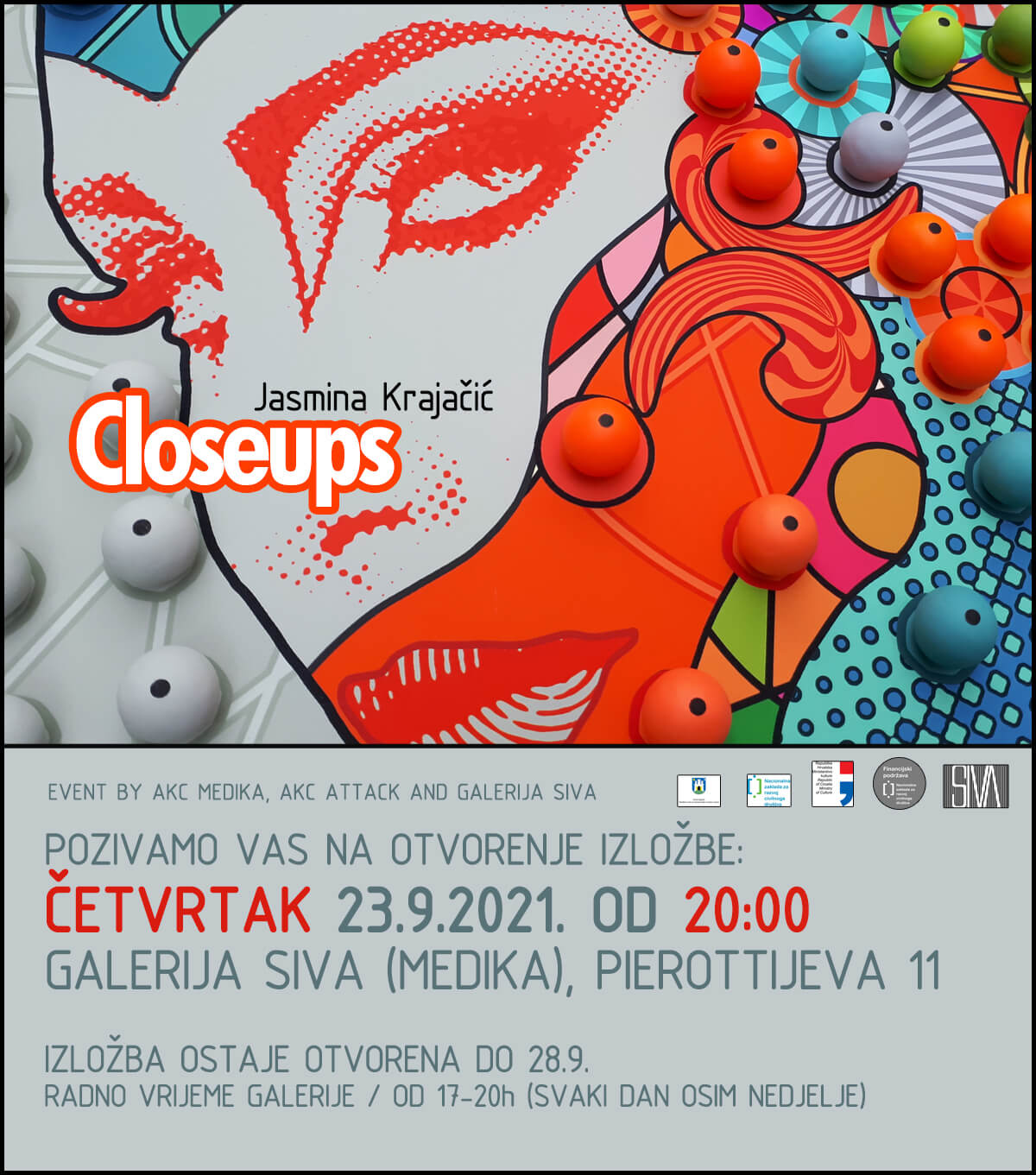
Invitation to the Closeups exhibition © Jasmina Krajačić
Tatjana Bezjak, a Croatian sculptor and writer, wrote a review of Krajačić's work which is going to be featured in the upcoming exhibition. She rated Krajačić's sixteen portraits as playful, attractive, full of colours, and invitingly cheerful. At first, Bezjak points out that these attributes are disturbing, but they bring out calm inside of us when we look at these close-ups and decipher some of the messages behind Krajačić's work ourselves.
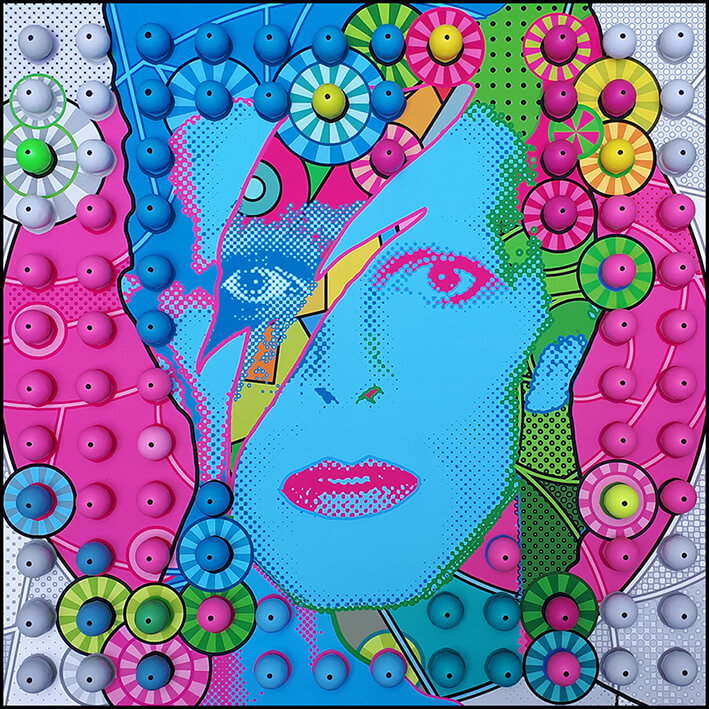
David Bowie © Jasmina Krajačić
''Close-ups are a look in the mirror, in the face of contemporary society, a society of consumerism and spectacle, deranged values and identity crises. Close-ups do not differ by the status, success or popularity of those in the portraits. Whether we belong to the anonymous crowd or to the shiny world of fame and celebrities, with commodities and identities, all of us are deceiving ourselves, without exception. While the invisible hand relentlessly serves new needs and practices, moving some final goalpost, some ultimate fulfillment is always further behind the horizon. It is almost impossible not to reach it, again and again“, writes Bezjak.
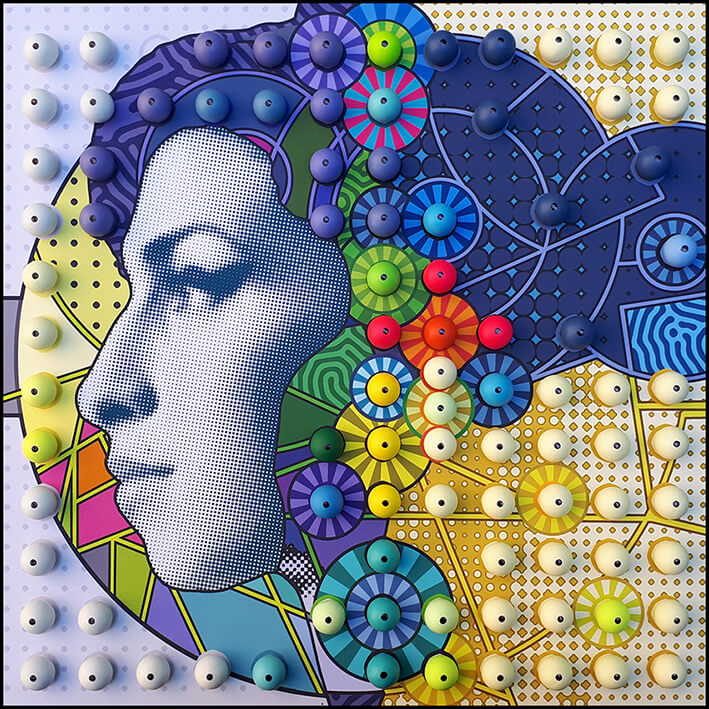
Amy Winehouse © Jasmina Krajačić
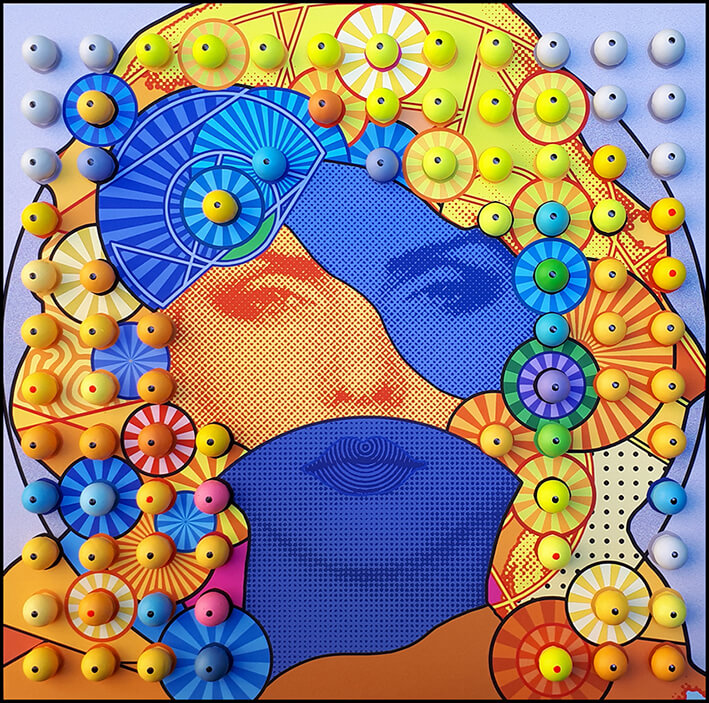
Blondie © Jasmina Krajačić
The criticism of the neo-liberal paradigm and constantly chasing profit consumerism is evident even in the name sof Krajačić's pictures. Titles that will be showcased in the exhibition such as ''Buy Passion'', ''Buy Patience'', ''Buy Empathy'', ''Buy Eternity'', ''Buy Wisdom'', ''Buy Dignity'', ''Buy Fearlessness'', ''Buy Affection'', accompanied by the eye-candy-like geometrical game of circles and colours, constantly force us to challenge our own identities.
The question posed to our identities is not necessarily difficult to answer with a simple yes or no, because of sheer complexity, but rather because it is a question we don't want to answer honestly: Are our identities genuine or bought?
Learn more about Croatian Art Galleries in Zagreb, Dalmatia, Istria & Slavonia on our TC page.
For more about art in Croatia, follow TCN's dedicated page.
World's Best Naive Art: Authentically Croatian Hlebine School
September 1, 2021 – We visit Podravina to discover the incredible Hlebine School of Croatian Naive Art
Croatia is sometimes difficult to find. Of course, with modern GPS and Croatia's nine international airports, getting here is no problem. But just where are you when you arrive?
Looking down at your dinner, the plate may hold a dish recognisable across the Mediterranean. Above your head, the architecture could be Roman, Austro-Hungarian or modern, indistinguishable. Ottoman influence lies everywhere from the best-loved handheld snacks to the mountain of slippers in every dwelling's doorway.
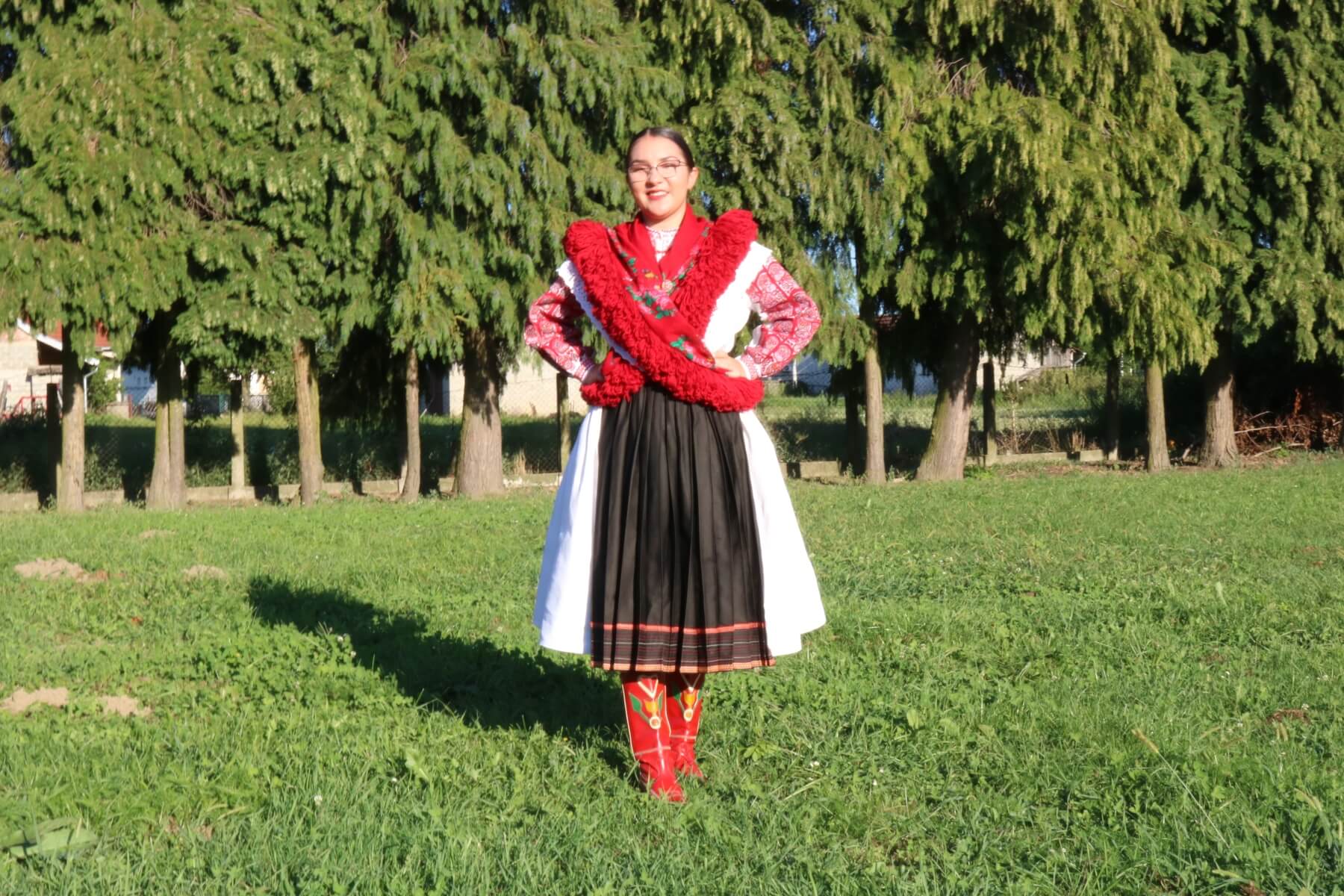 A friendly local wears the folk costume of the small region surrounding Koprivnički Ivanec, near Koprivnica. The costume features the incredibly intricate Ivanečki vez embroidery, which has been safeguarded locally for over 90 years and is now a protected part of Croatia's cultural heritage. Photo © Marc Rowlands.
A friendly local wears the folk costume of the small region surrounding Koprivnički Ivanec, near Koprivnica. The costume features the incredibly intricate Ivanečki vez embroidery, which has been safeguarded locally for over 90 years and is now a protected part of Croatia's cultural heritage. Photo © Marc Rowlands.
Actually, the true essence of the country you'll find in the Croatians themselves. And yet, their history is all too often obscured by the impositions of empires that once were here. However, we can find this history away from the major cities, the centres of influence. We find it in the villages. Specifically, in their folk costume, their folk song and folk dance. And we find it in the art there.
What is Naive Art?
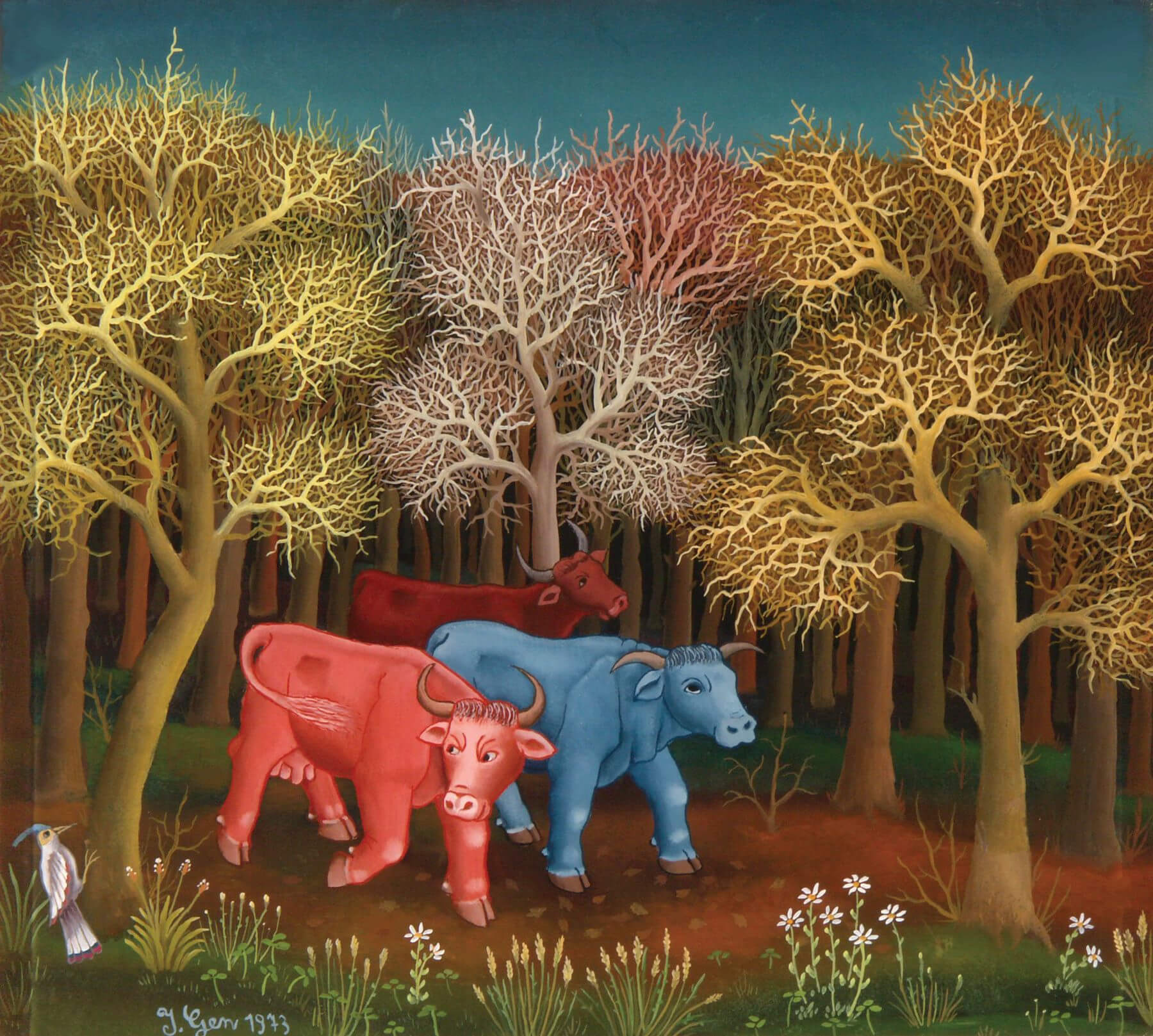 Cows In The Woods by Ivan Generalić, hanging at the Galerija naivne umjetnosti (Gallery of Naive Art), Hlebine © Koprivnica Town Museum
Cows In The Woods by Ivan Generalić, hanging at the Galerija naivne umjetnosti (Gallery of Naive Art), Hlebine © Koprivnica Town Museum
Naive art is any art made by someone who has received no formal or classical training. In this sense, the earliest discovered art of humans – cave paintings – are naïve art. However, there is nothing the classical art world likes more than specifically defining art movements. And, to them, the modern era of European Naive Art begins in the late 19th Century, with a growing appreciation of painters like French Post-Impressionist Henri Rousseau (1844–1910).
Because of the lack of formal, classical or academic training, it is said that common characteristics exist within the work of many Naive Artists. Specifically, these characteristics stem from an ignorance of strict perspective. Naive Artists often do not mute colours or lessen detail with distance. Also, they often don't attempt to accurately decrease the size of objects at distance.
Croatian culture as a part of national identity
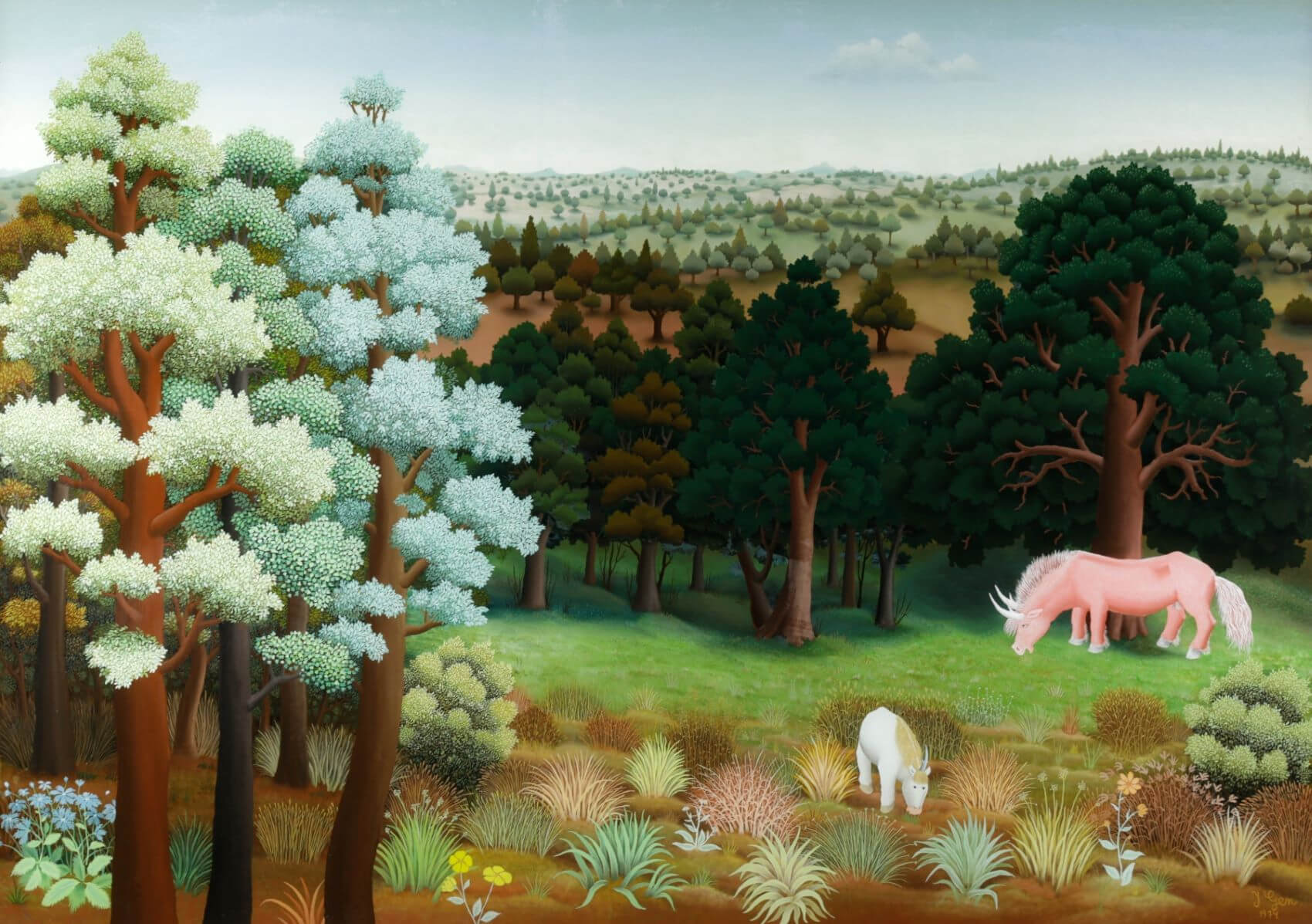 Horned horse by Ivan Generalić, hanging at the Galerija naivne umjetnosti (Gallery of Naive Art), Hlebine © Koprivnica Town Museum
Horned horse by Ivan Generalić, hanging at the Galerija naivne umjetnosti (Gallery of Naive Art), Hlebine © Koprivnica Town Museum
Croatian Naive Art is one of the best recognised and best-loved in the world. In truth, Croatia's movement doesn't begin to emerge until well into the 20th Century. Although, it is important to view the country's Naive Art within its broader search for a Croatian national identity. The roots of this movement stem back over 100 years prior to the emergence of Croatian Naive Art, beginning with the foundation of the Illyrian movement, Matica Hrvatska and more.
This older movement of national awakening had strong preoccupations with language, written text and cultural identity. Actually, its instigators were very much the educated intelligentsia of cities like Zagreb.
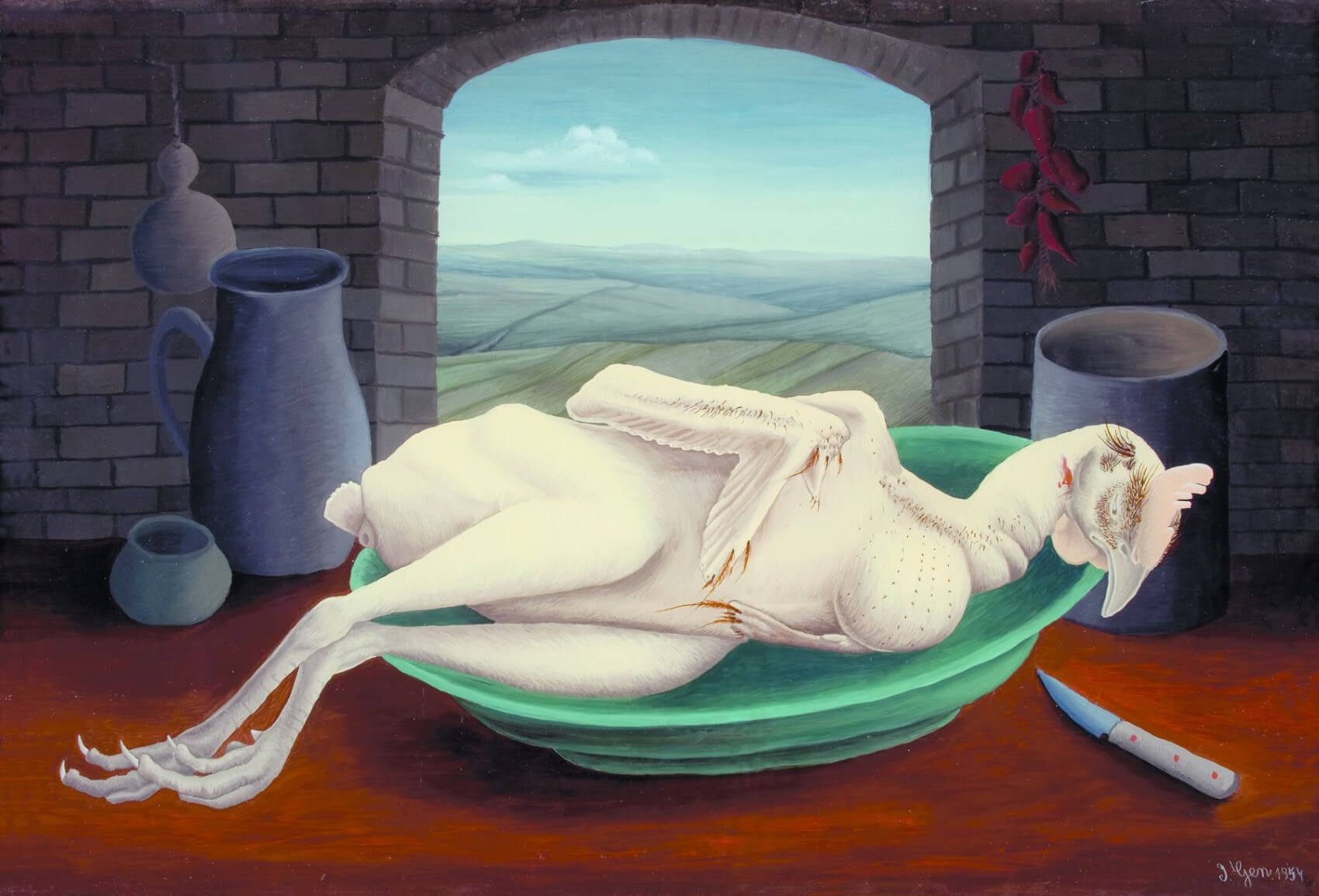 'A Battered Rooster' by Ivan Generalić, hanging at the Galerija naivne umjetnosti (Gallery of Naive Art), Hlebine © Koprivnica Town Museum
'A Battered Rooster' by Ivan Generalić, hanging at the Galerija naivne umjetnosti (Gallery of Naive Art), Hlebine © Koprivnica Town Museum
Before the end of World War I, Russia had undergone two revolutions. After the war, the German, Austro-Hungarian and Ottoman empires collapsed. Much of Europe was plunged into over half a decade of political upheaval - revolts, unrest and strikes by workers. Mostly socialist in sentiment - organised by workers and disillusioned former soldiers – this unrest and the accompanying birth of new nations lay not in the hands of the inner-city intelligentsia. And, many believed the cultural and artistic expression which reflected this new era should also come from the proletariat.
Krsto Hegedušić and the Earth Group (Grupa Zemlja)
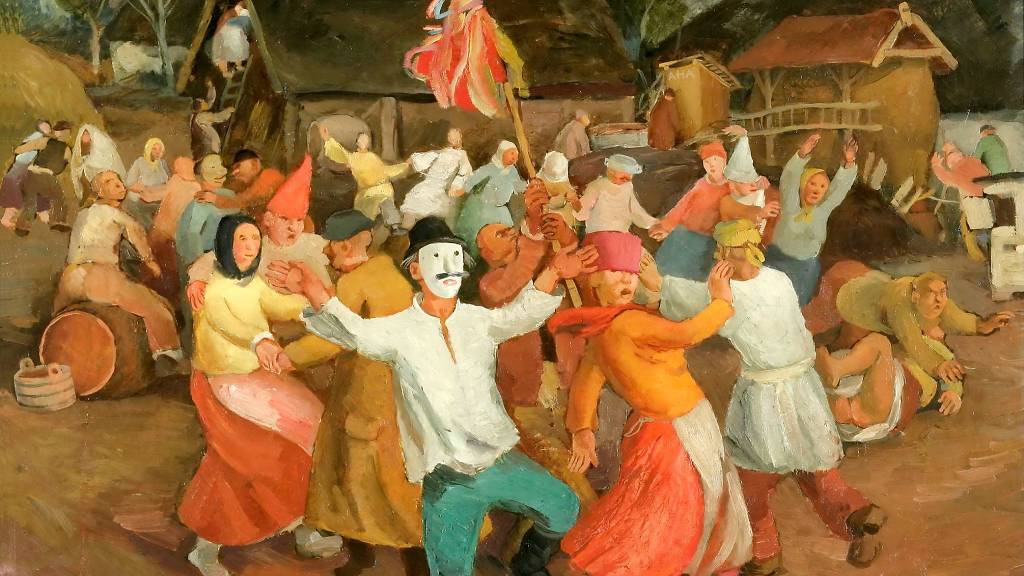 Krsto Hegedušić 'poklade' © Muzej moderne i suvremene umjetnosti Rijeka (MMSU)
Krsto Hegedušić 'poklade' © Muzej moderne i suvremene umjetnosti Rijeka (MMSU)
One Croat who believed strongly in this was painter Krsto Hegedušić. He co-founded the Earth Group in 1929 during a challenging period for Croatia. Europe was still reaping the dire economic repercussions of the First World War. Croatia had finally been freed of Austro-Hungarian hegemony, only to be forced into existing within another monarchy.
The founding beliefs of the Earth Group were that authentic artistic expression should be a product of the time and space whence it came and should be free of foreign influence. Art should not be created for the sake of art, but to depict an actual reality.
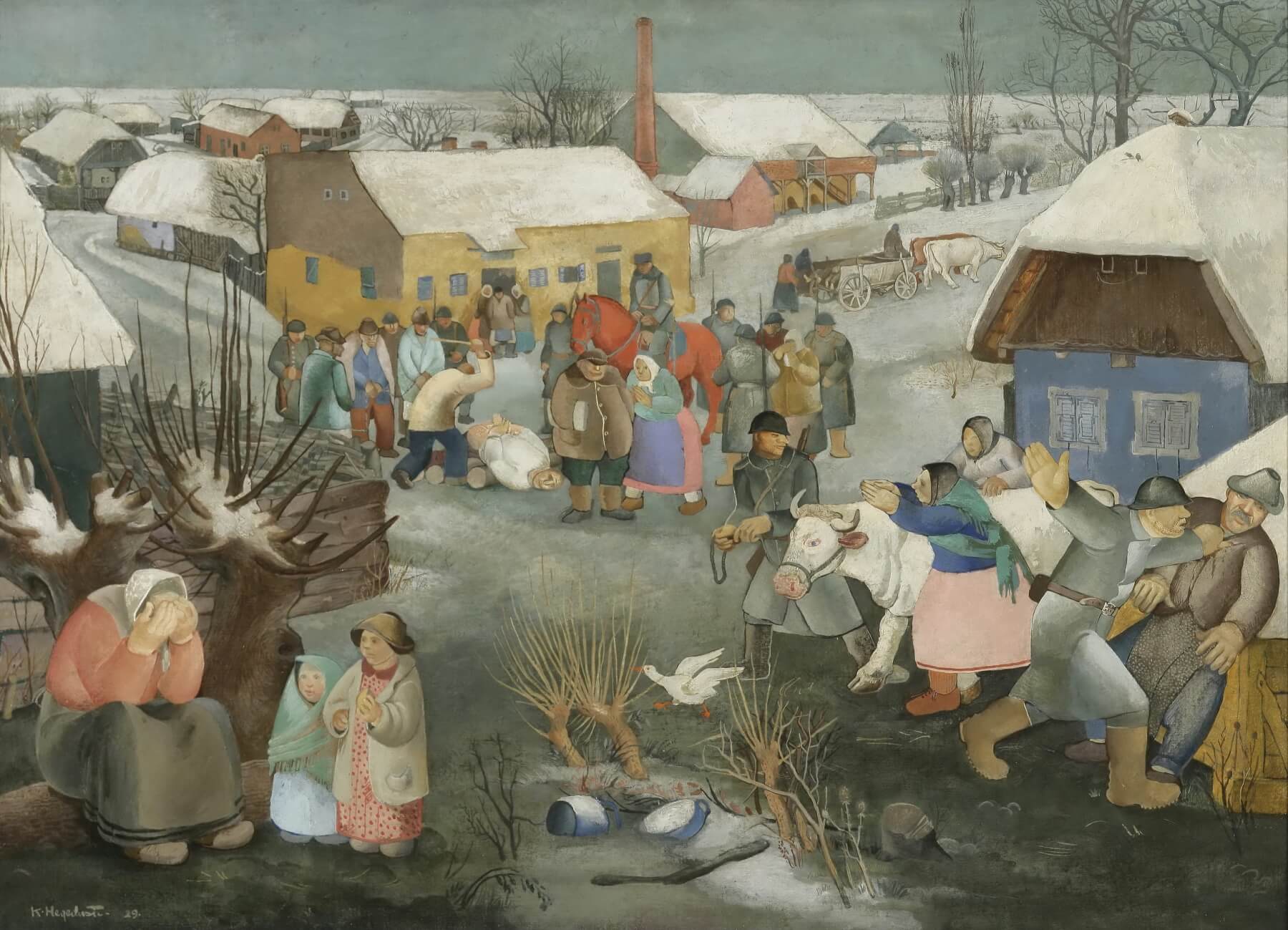 Krsto Hegedušić 'Rekvizicija (Requisition)', 1929 © Museum of Modern and Contemporary Art, Rijeka
Krsto Hegedušić 'Rekvizicija (Requisition)', 1929 © Museum of Modern and Contemporary Art, Rijeka
Krsto Hegedušić himself was very much a product of his studies. In 1920 he enrolled in what is today the Academy of Fine Arts in Zagreb. After graduating, he spent an additional two years on a scholarship in Paris. And yet, as a painter, his subject matter often reflected the world around him. Social critiques, within his work he depicted everyday poverty and the exploitation of Croatian peasants.
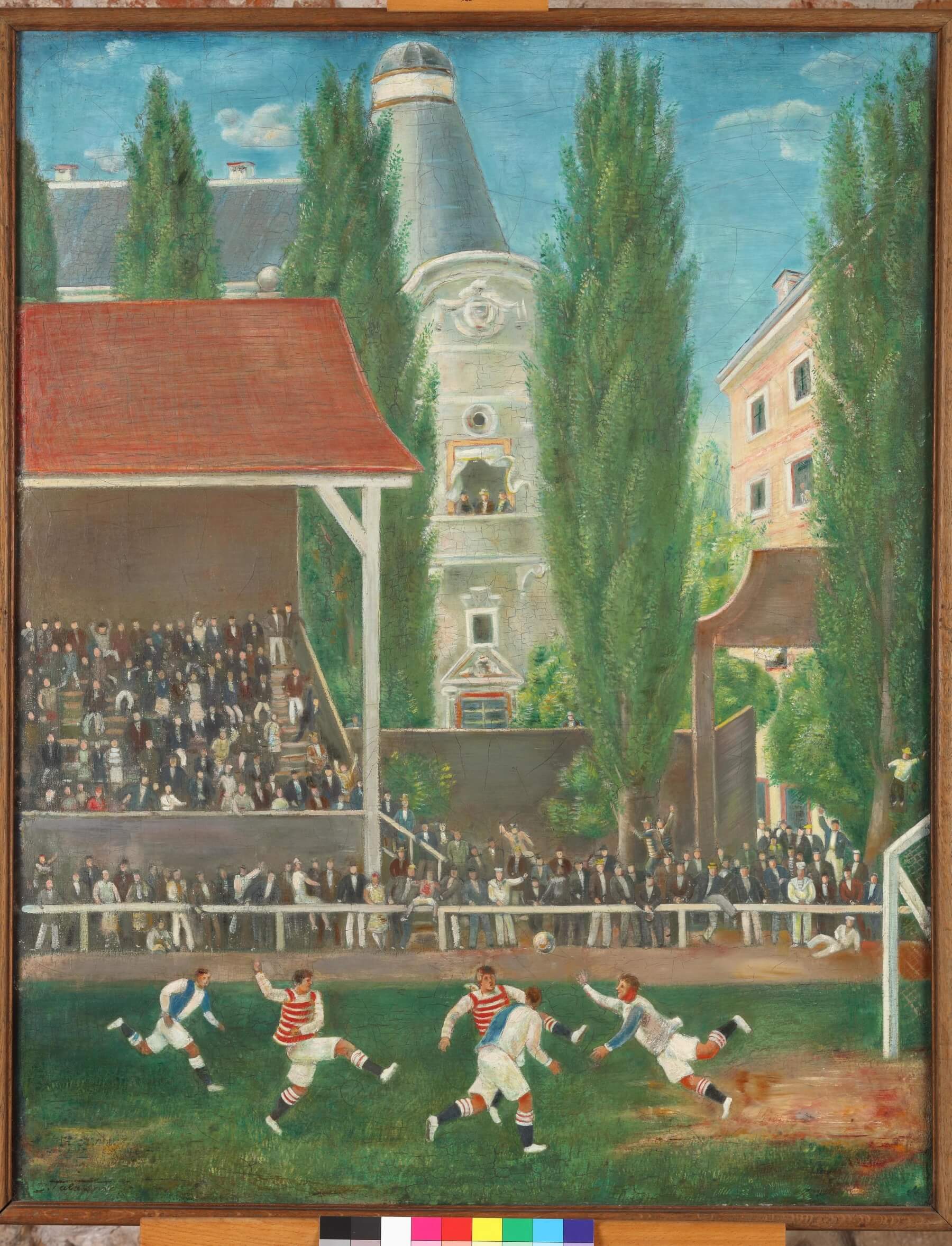 'Football match' by another of the Earth Group's founding members, Ivan Tabaković, 1927 © Gallery of Matica srpska, Novi Sad
'Football match' by another of the Earth Group's founding members, Ivan Tabaković, 1927 © Gallery of Matica srpska, Novi Sad
Born in Petrinja, Krsto Hegedušić spent summer holidays in the idyllic countryside and agricultural land surrounding his father's birth village of Hlebine, Podravina. When he was aged just 8 years old, Krsto's father died. Subsequently, the family moved to Hlebine. Later, Krsto would spend time living in Zagreb, not least for the duration of his studies. But, just one year into the life of the Earth Group, Krsto Hegedušić discovered a teenage artist back in Hlebine.
Hlebine School First Generation: Ivan Generalić, Franjo Mraz and Mirko Virius
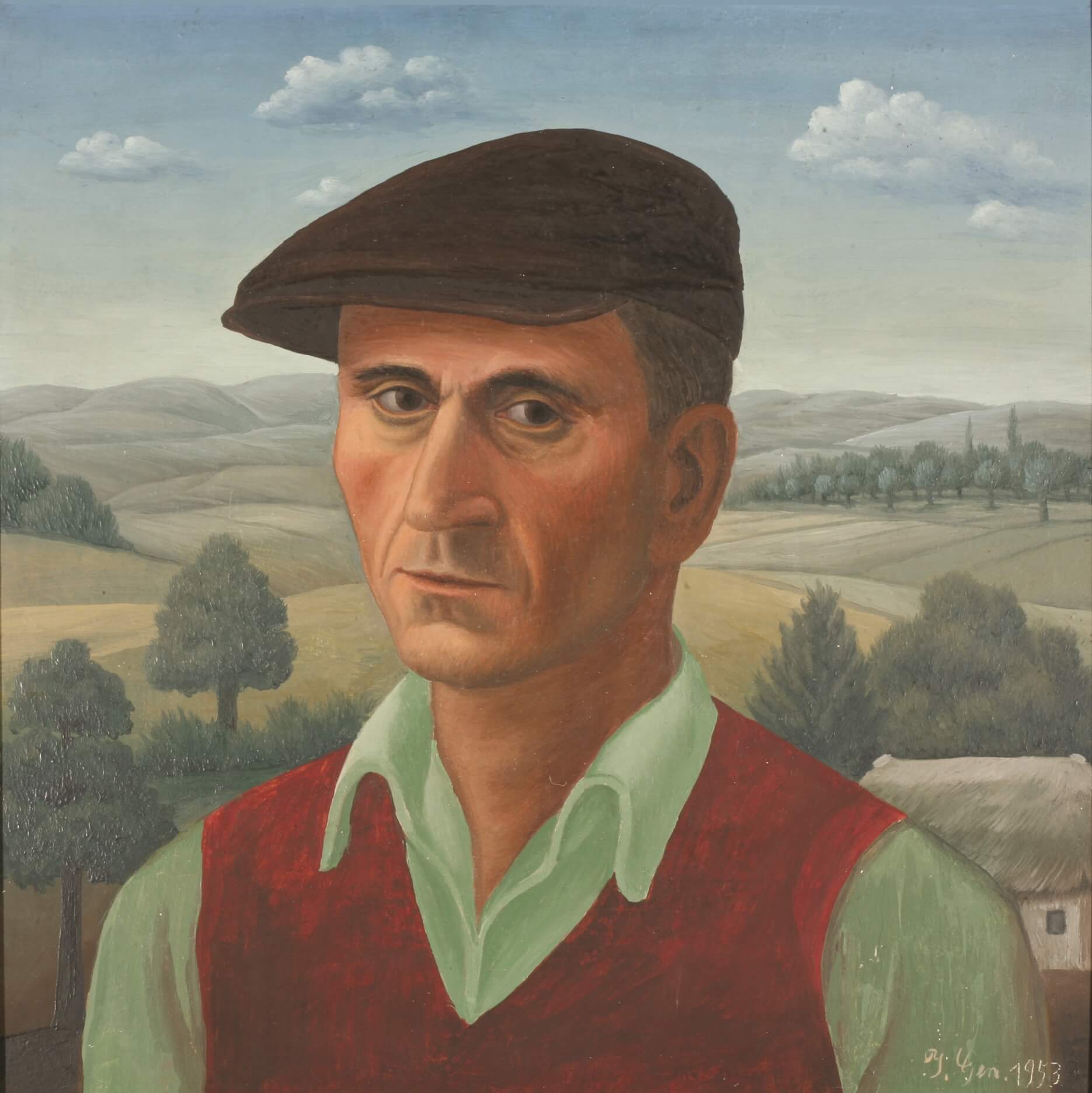 Self-portrait by Ivan Generalić, hanging at the Galerija naivne umjetnosti (Gallery of Naive Art), Hlebine. Photo © Koprivnica Town Museum
Self-portrait by Ivan Generalić, hanging at the Galerija naivne umjetnosti (Gallery of Naive Art), Hlebine. Photo © Koprivnica Town Museum
When we speak of the Hlebine School within Croatian Naive Art we are not actually talking about a building, an institution of learning. After all, the very definition of a Naive Artist is they are not classically trained. Instead, the Hlebine School is a discipline. And, more so than any Croatian Naive Art that followed, it is quite easy to define.
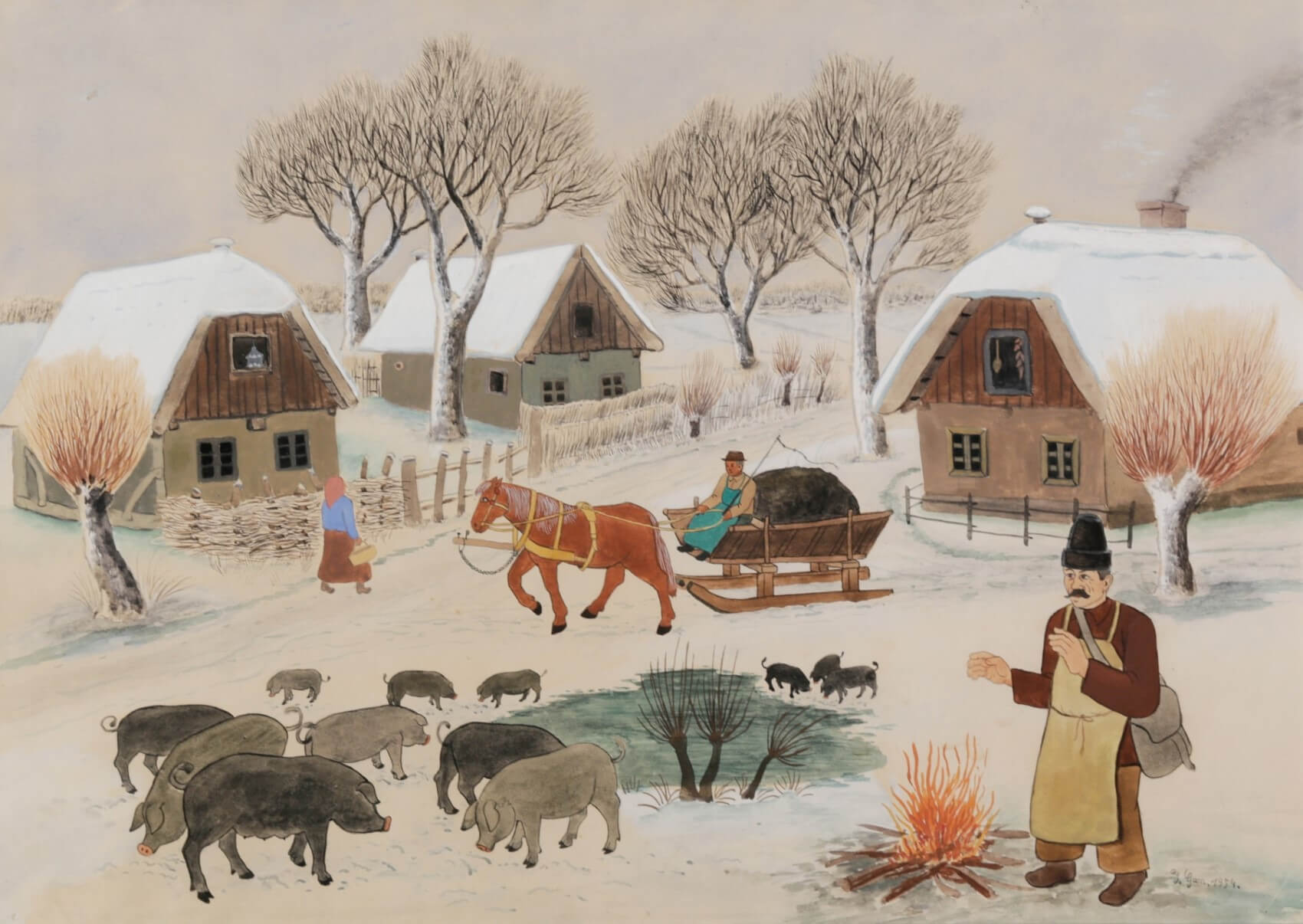 'Kanas' by Ivan Generalić, hanging at the Galerija naivne umjetnosti (Gallery of Naive Art), Hlebine © Koprivnica Town Museum
'Kanas' by Ivan Generalić, hanging at the Galerija naivne umjetnosti (Gallery of Naive Art), Hlebine © Koprivnica Town Museum
Within its first generation, the three most prominent artists are Ivan Generalić, Franjo Mraz and Mirko Virius. Both Ivan Generalić and Franjo Mraz were born, lived and were discovered by Krsto Hegedušić in the village of Hlebine. Mirko Virius was from Đelekovec, less than 15 kilometres to their north-west.
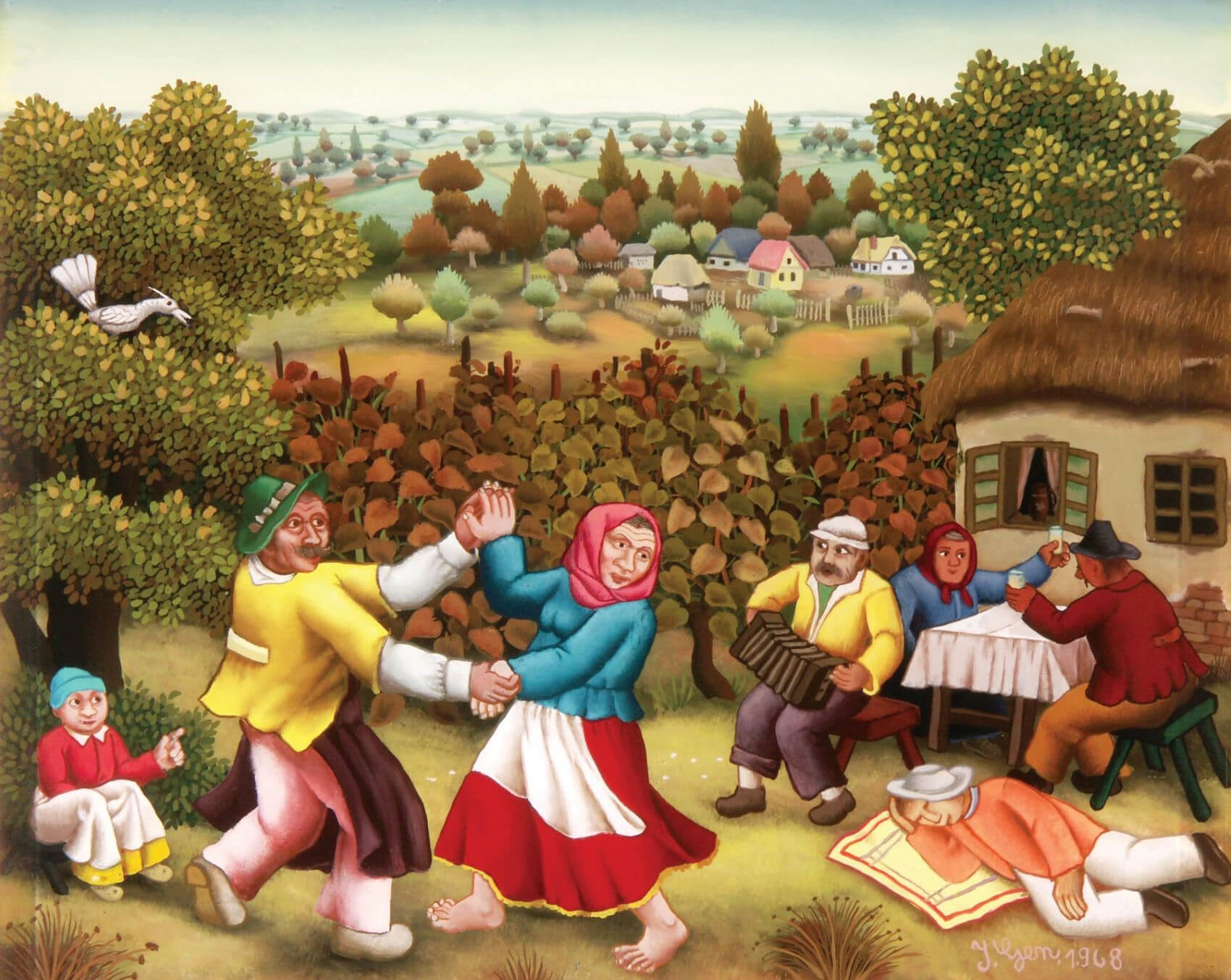 'Ples v goricaj' by Ivan Generalić, hanging at the Galerija naivne umjetnosti (Gallery of Naive Art), Hlebine © Koprivnica Town Museum
'Ples v goricaj' by Ivan Generalić, hanging at the Galerija naivne umjetnosti (Gallery of Naive Art), Hlebine © Koprivnica Town Museum
Key to identifying the Hlebine School in its First Generation is the subject matter. All three of these artists painted the world around them – their neighbours and peers, living everyday lives, in the villages, landscape and towns of today's Koprivnica-Križevci County. Certainly, Krsto Hegedušić helped inspire this subject matter, moulding the artists to suit the ethos of the Earth Group.
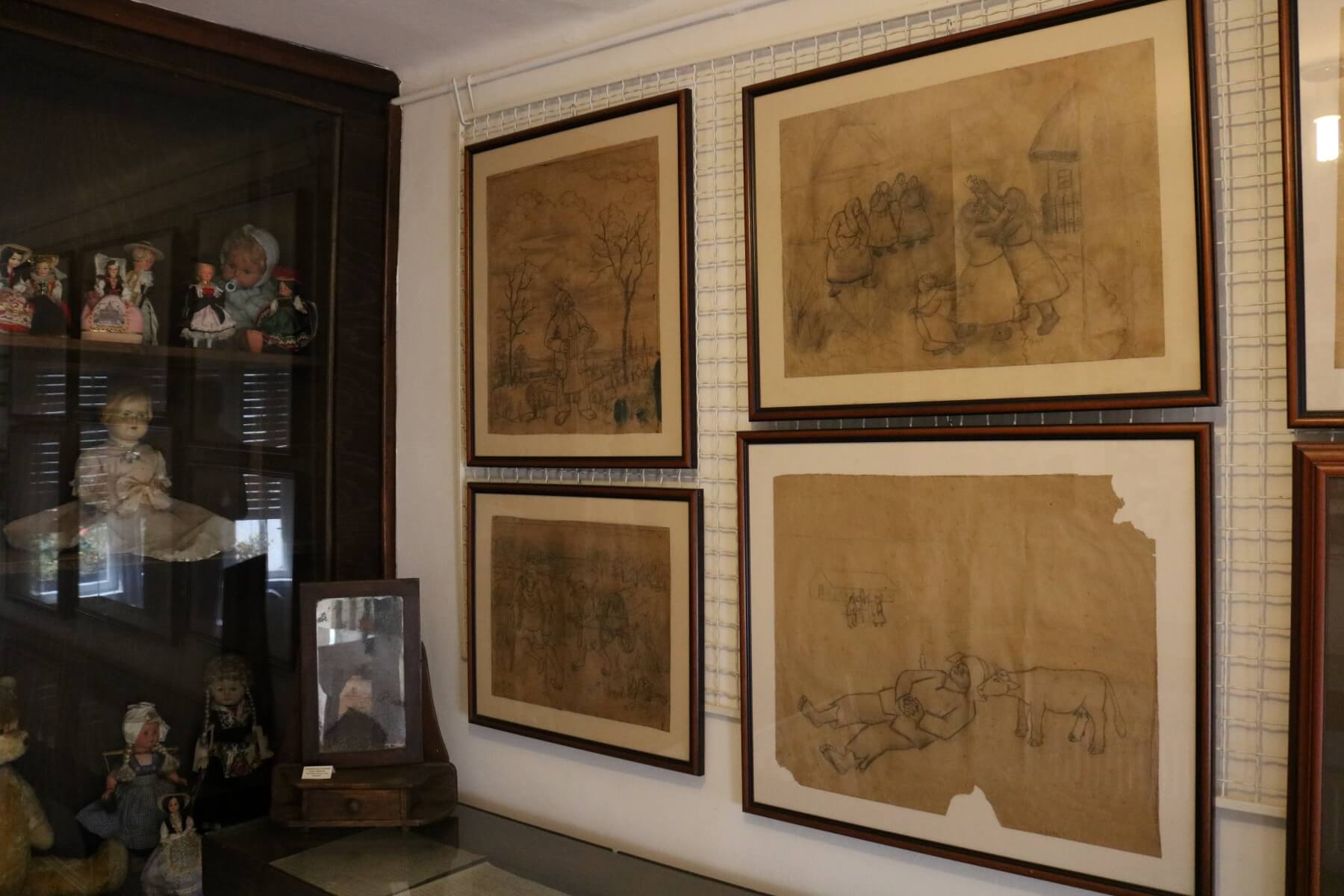
Ivan Generalić was just 16 years old when discovered by Krsto Hegedušić in 1930. The meeting would have a fast and long-lasting impact on Generalić. Ivan's humble early canvasses were the brown paper bags used in the business of a close relative. Yet, within a year of meeting Hegedušić, Ivan Generalić found his work being exhibited in Zagreb.
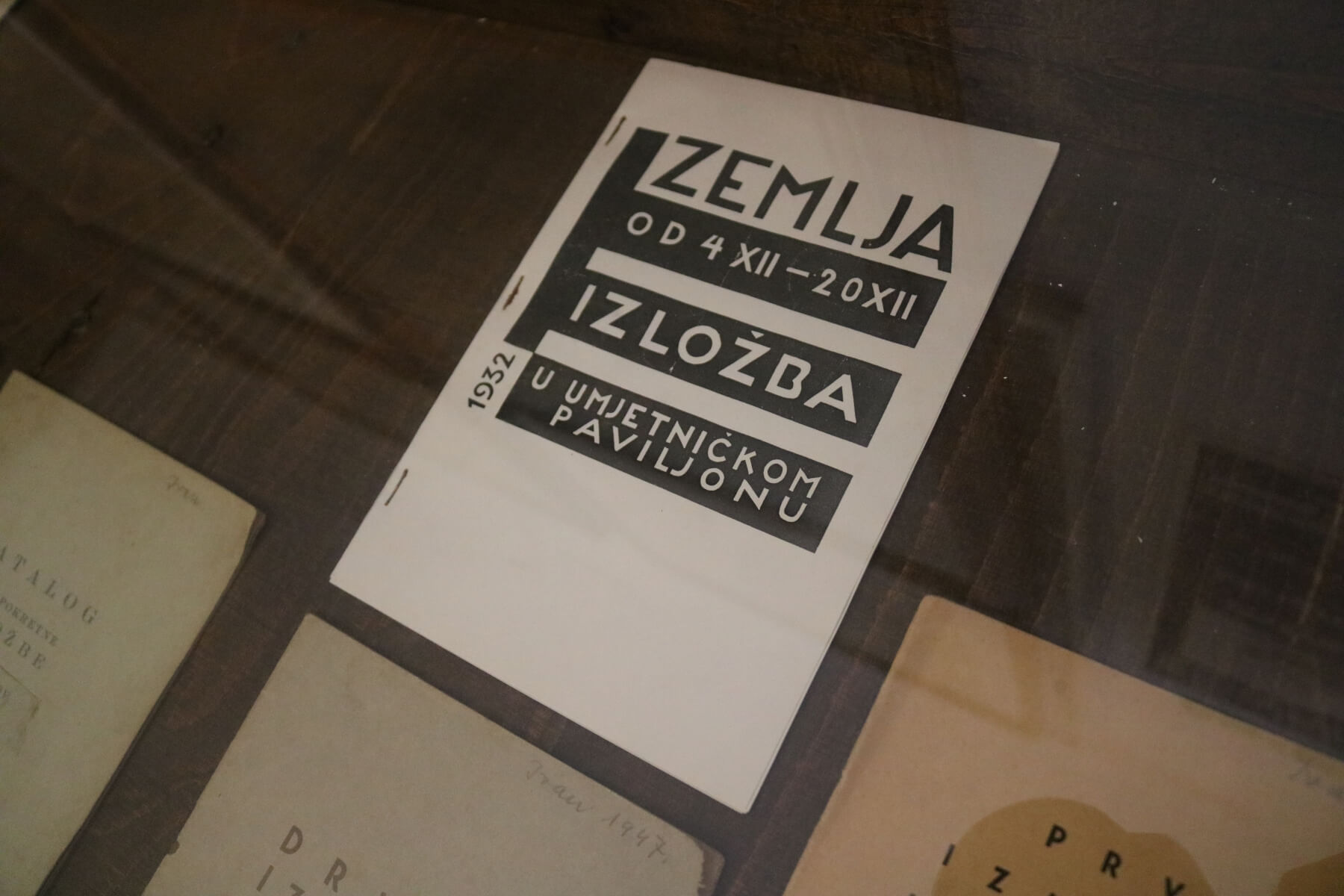
Hegedušić's shaping of the artists didn't obliterate their existing perspectives as much as it simply shifted them. For instance, Hegedušić's advice might have been "Instead of painting the church, why not paint people walking to the church in the snow?" or "Instead of marking the religious holiday by painting its origin story, why not show how you and your neighbours celebrate this holiday?"
Whether Hegedušić was conscious of doing it, or whether the artists were willfully lead, this guidance ultimately had the effect of politicising their work. In turn, this would lead the most authentic of all Croatian art into dangerous times when fascists took over the country. Proletarian in their themes, the Hlebine School and the Earth Group became viewed as Communist. The latter group was banned and Hegedušić arrested several times. During the Second World War, Mirko Virius was arrested, taken to a concentration camp in Zemun and executed. Ivan Generalić's painting of the sorrowful incident, 'The Death of Virius', is among his most famous. Franjo Mraz was also arrested during World War II but managed to escape.
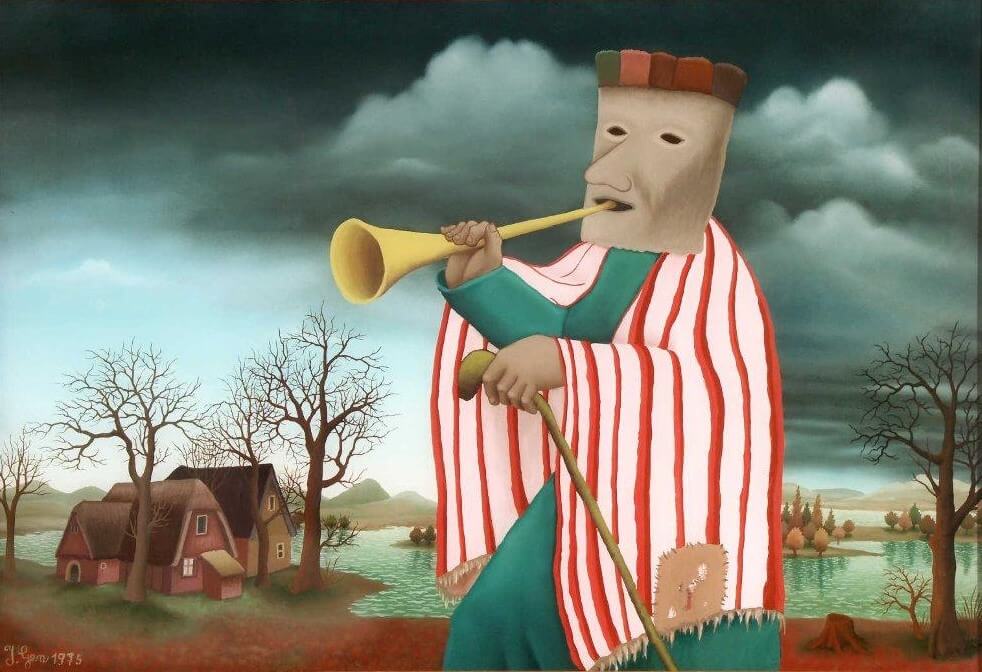 'Mask' by Ivan Generalić, hanging at the Galerija naivne umjetnosti (Gallery of Naive Art), Hlebine © Koprivnica Town Museum
'Mask' by Ivan Generalić, hanging at the Galerija naivne umjetnosti (Gallery of Naive Art), Hlebine © Koprivnica Town Museum
Aside from informing the subject matter of their work, Hegedušić also educated the painters in different techniques. One of these techniques – painting on glass – would become an enduring component of the Hlebine School and Croatian Naive Art.
Painting on glass
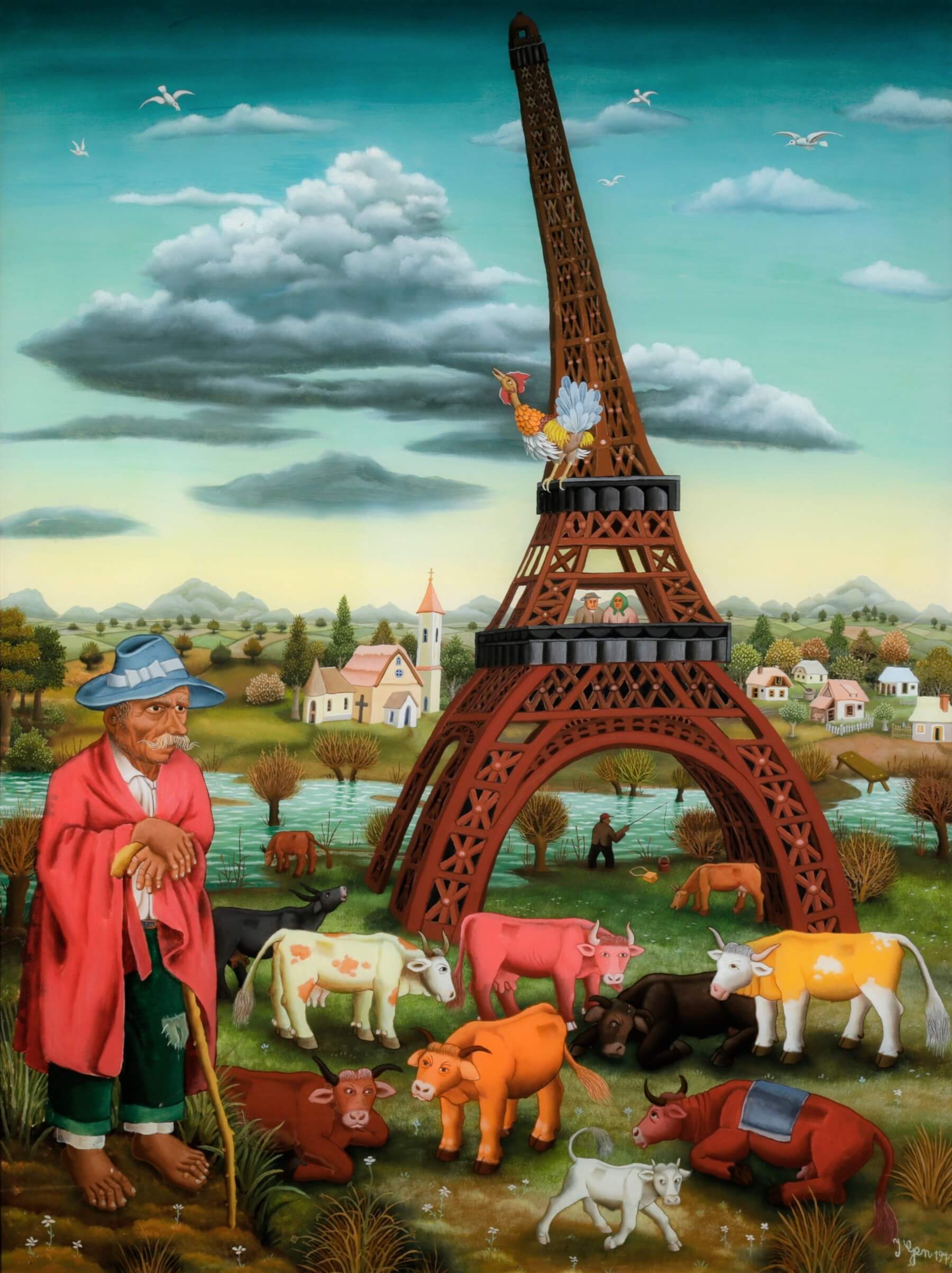 'Eiffel Tower' by Ivan Generalić. The original hangs at Galerija naivne umjetnosti (Gallery of Naive Art), Hlebine © Koprivnica Town Museum
'Eiffel Tower' by Ivan Generalić. The original hangs at Galerija naivne umjetnosti (Gallery of Naive Art), Hlebine © Koprivnica Town Museum
Copying the style from imported religious art, when Hlebine School artists learned to paint on glass, it gave their efforts several distinct qualities. Firstly, if stored in the right conditions – away from damaging light – the glass protects the colours of the paint. As a result, much Hlebine School art is as brilliantly vivid today as the day it was first painted.
Secondly, this format makes the works heavy and fragile. Several masterpieces have been lost by falling to the floor and smashing.
Thirdly, painting on glass is time-consuming and challenging. Each painting must be thought out and planned in advance. The painter initially makes a sketch or preliminary painting as a guide. The image is then transferred to glass effectively in reverse. Details in the forefront of the painting must be applied first, with the background painted on top. Throughout the process, the artist will continuously check their progress on the opposite side of the glass.
Hlebine School Second Generation and onwards: Josip Generalić, Ivan Večenaj, Ivan Lacković, Mijo Kovačić, Franjo Filipović, Dragan Gaži
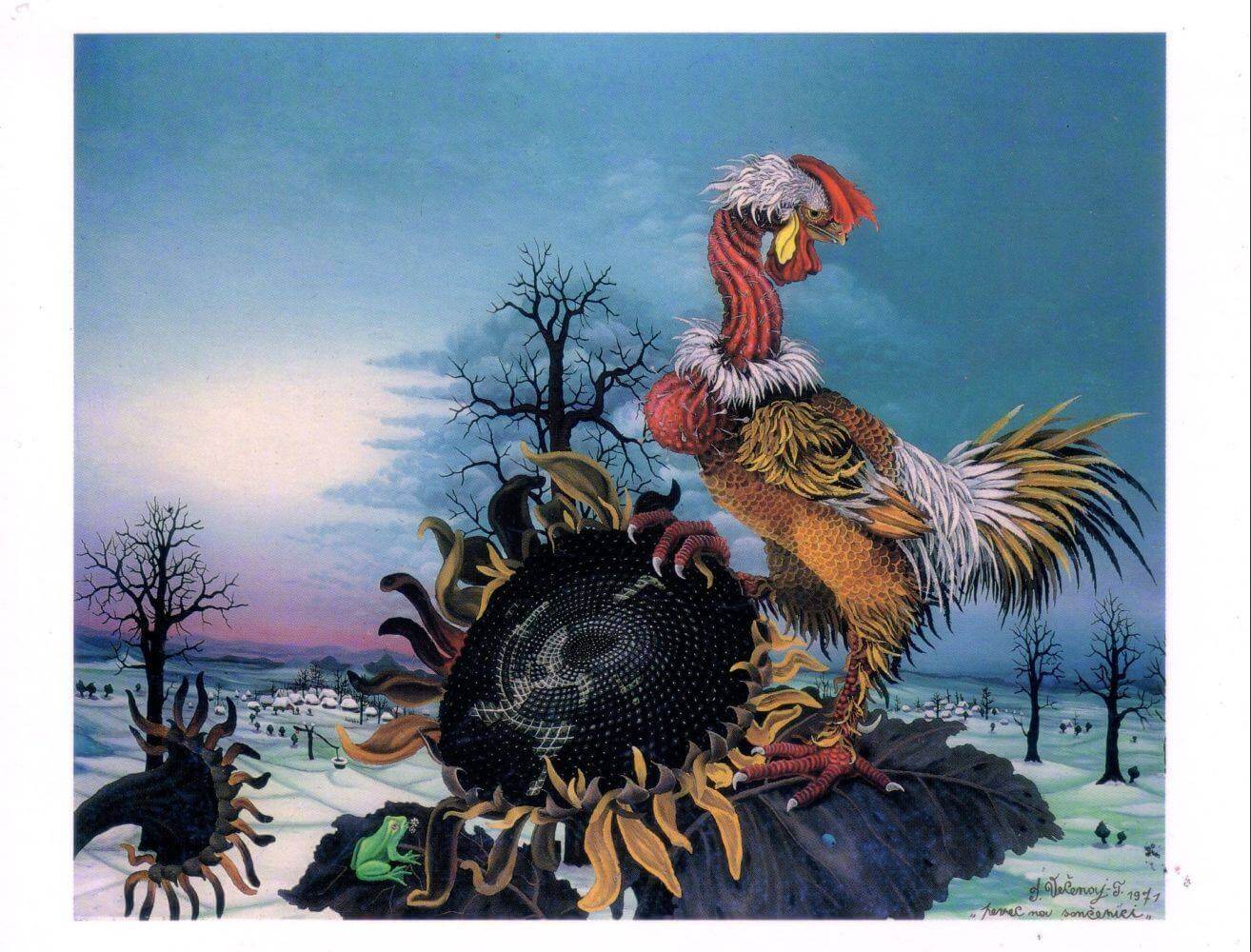 Rooster on Sunflower by Ivan Večenaj © Galerija Ivan Večenaj
Rooster on Sunflower by Ivan Večenaj © Galerija Ivan Večenaj
Perhaps to their surprise, the painters of Hlebine School first generation became a big hit. Exhibitions of their work were appreciated first in Zagreb. But, then the exhibitions began to tour across Yugoslavia and eventually the art capitals of the world. This attention would help inspire a new generation of artists from Hlebine and the surrounding area.
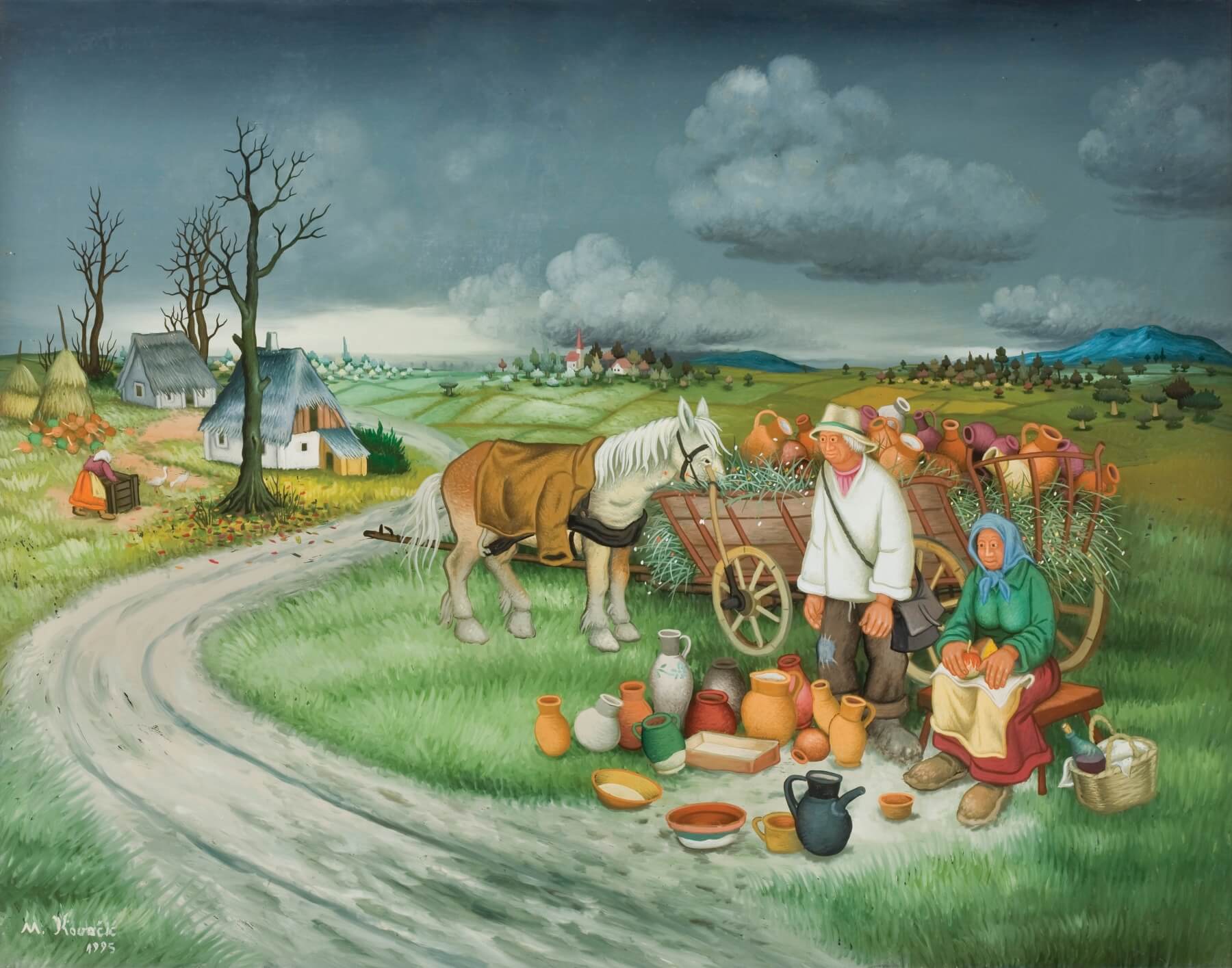 'Lončari' by Mijo Kovačić at Galerija Mijo Kovačić © Koprivnica Town Museum
'Lončari' by Mijo Kovačić at Galerija Mijo Kovačić © Koprivnica Town Museum
Success for the Hlebine School artists showed that Croatian art and self-expression were valid and valued even if unstudied. Thereafter, the tiny village of Hlebine would never look the same. More and more Naive Artists and folk artists were inspired to create. Still to this day, many continue.
While some Hlebine School artists carried on the tradition of painting on glass, others were inspired to sculpt in wood or, like Mirko Virius, paint on canvas. One of the key distinctions between later generations of the Hlebine School and the first is the subject matter.
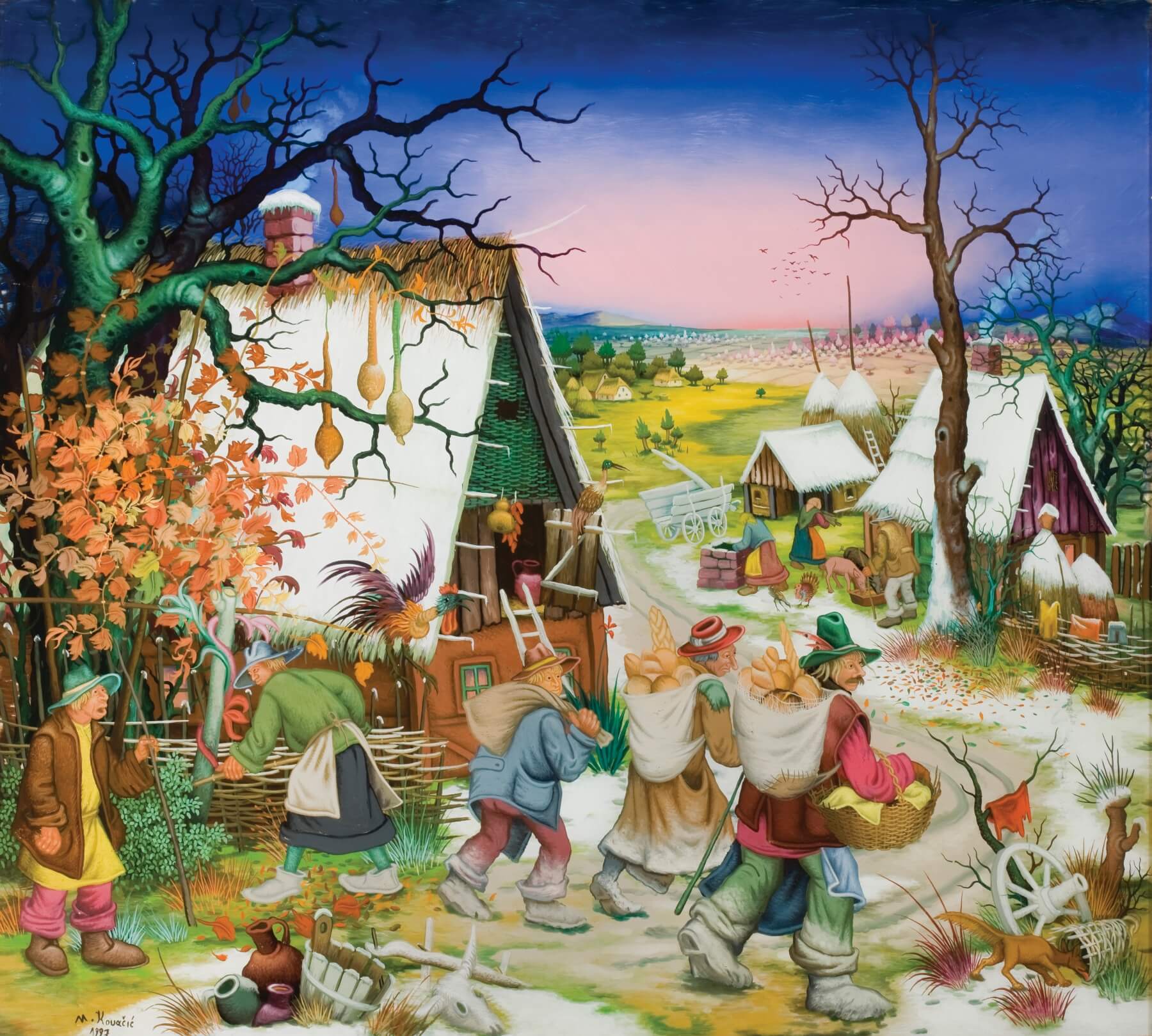 Podravina bread sellers in a picture hanging at Galerija Mijo Kovačić © Koprivnica Town Museum
Podravina bread sellers in a picture hanging at Galerija Mijo Kovačić © Koprivnica Town Museum
Second and then third generation Hlebine School artists were inspired to paint folklore, fantasy, from imagination, and with symbolic uses of vivid colur. This broadening of the style was partially the influence of Dimitrije Bašičević Mangelos, the first curator of the Gallery of Primitive Art in Zagreb (today Croatian Museum of Naïve Art). Subsequently, many of these later works would not fit within the paradigms of the Earth Group.
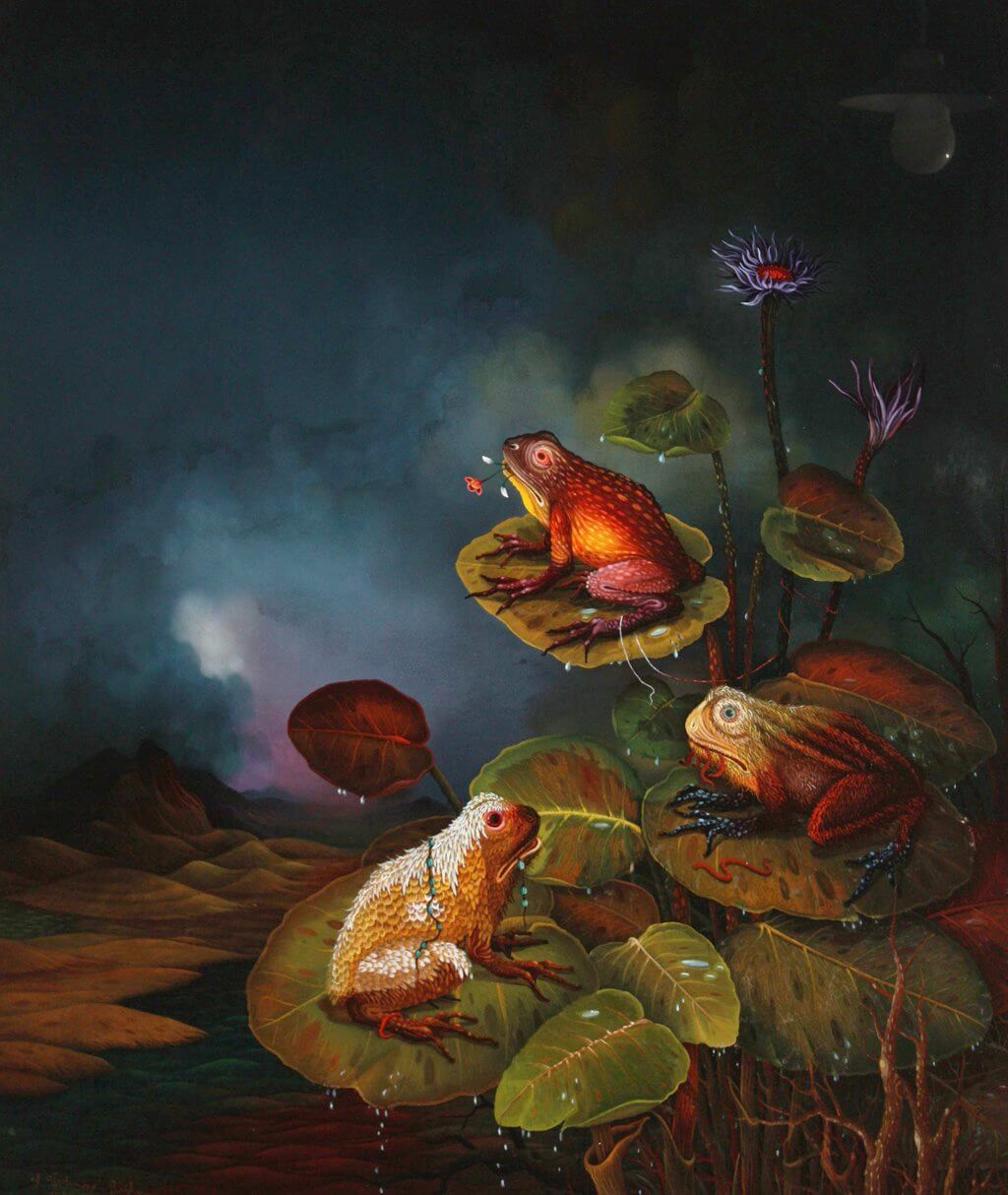 'Žabe (Frogs)' by Ivan Večenaj © Galerija Ivan Večenaj
'Žabe (Frogs)' by Ivan Večenaj © Galerija Ivan Večenaj
For example, some of Ivan Večenaj's sacral paintings clearly come from the author's imagination and not his actual vision. Similarly, Josip Generalić, son of Ivan, travelled far beyond the limits of his home village in pursuit of his socio-political subject matter. Both artists were concerned with environmental issues on a global, not just a local level. Although, their work is still inextricably linked to their locale; Večenaj works the Podravina rooster emblem into many of his paintings and even depicts Christ within a Podravina landscape. So too does Josip Generalić when he paints The Beatles and others from the 60s counterculture movement.
On the Trail of the Hlebine School in Podravina & Prigorje, Home of the Treasures of Croatian Naive Art
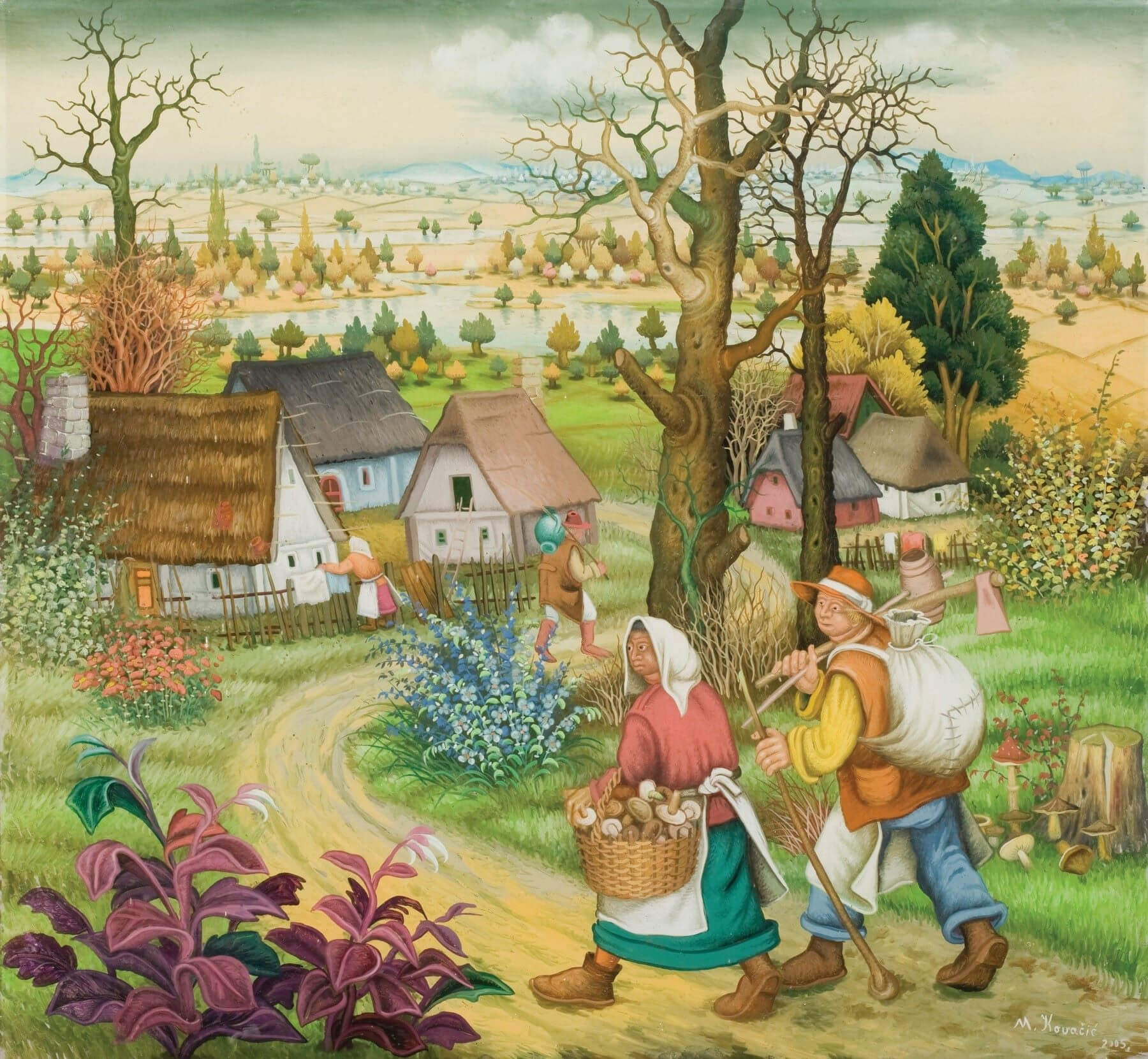 Locals return from mushroom picking in autumnal Podravina in a picture hanging at Galerija Mijo Kovačić © Koprivnica Town Museum
Locals return from mushroom picking in autumnal Podravina in a picture hanging at Galerija Mijo Kovačić © Koprivnica Town Museum
Some Croatian Naive Art is held in private and public collections across the world. Some of it finds a home in the National Museum of Naive Art in Zagreb. However, the vast majority of treasures from the Hlebine School of Croatian Naive Art remain in Podravina & Prigorje. The national Museum of Naive Art in Zagreb is currently closed as it undergoes the lengthy process of changing address. As a result, the following addresses in Koprivnica-Križevci County are currently the best places to see the most authentically Croatian of all the country's art.
Also, because the landscape of Hlebine, Koprivnica and wider Podravina appears in so much Hlebine School art, you genuinely need to come here to view both together. You'll get a much better understanding and appreciation of this art when you see it in its natural surroundings.
Galerija Mijo Kovačić, Koprivnica Town Museum, Koprivnica
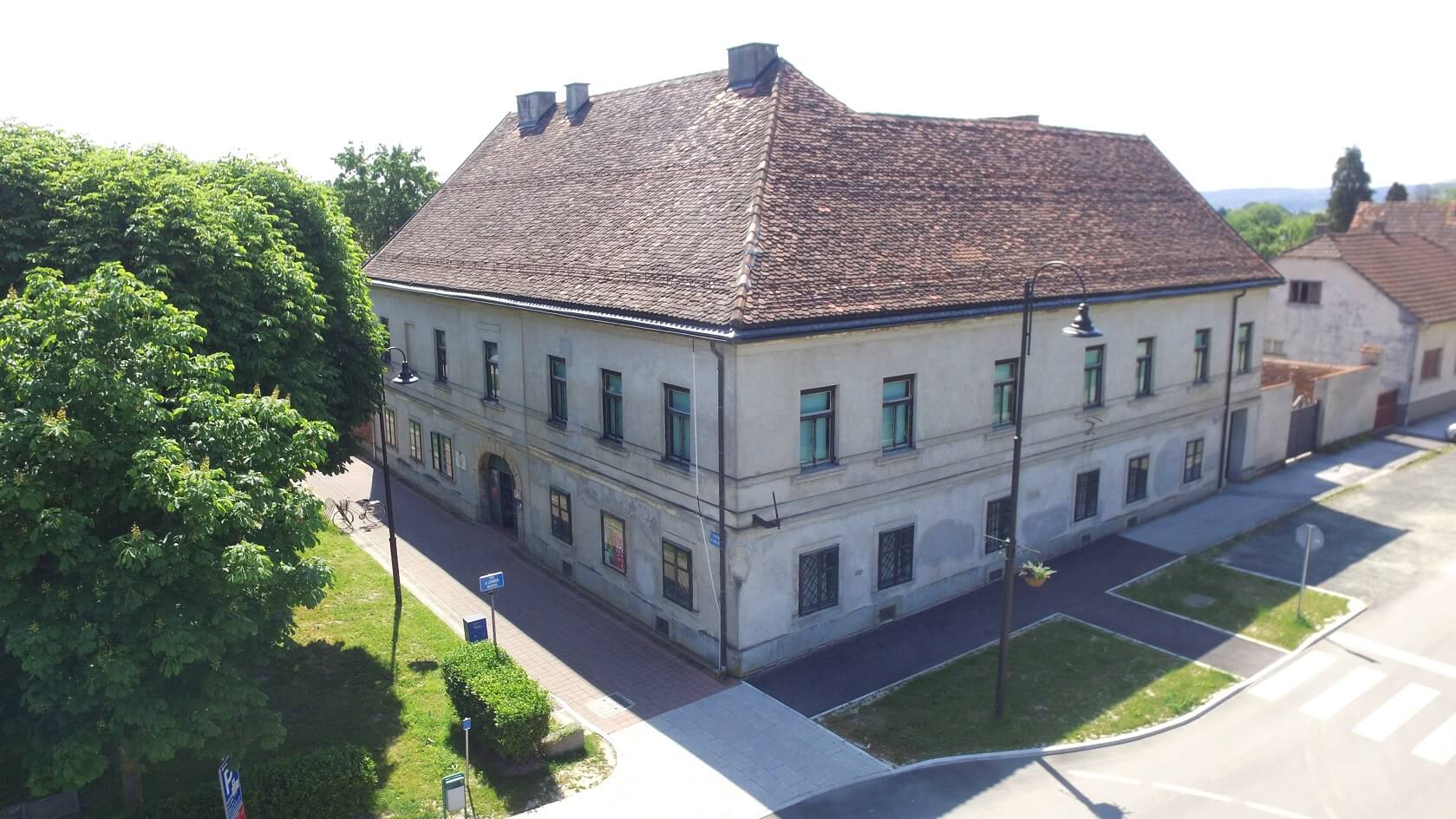 Koprivnica Town Museum © Koprivnica Town Museum
Koprivnica Town Museum © Koprivnica Town Museum
Born 5 August 1935 in Gornja Šuma, Molve, Podravina, Mijo Kovačić is one of the last remaining Croatian Naive Artists of the Hlebine School's second generation. He still paints today, albeit not quite as prolifically as in the past. He has produced such a body of work that not only can you find him exhibited in Croatian Museum of Naïve Art in Zagreb, but also in dedicated Mijo Kovačić galleries in Zagreb and Koprivnica. The one is run by Koprivnica Town Museum, which you can see above. Find out more about the gallery here.
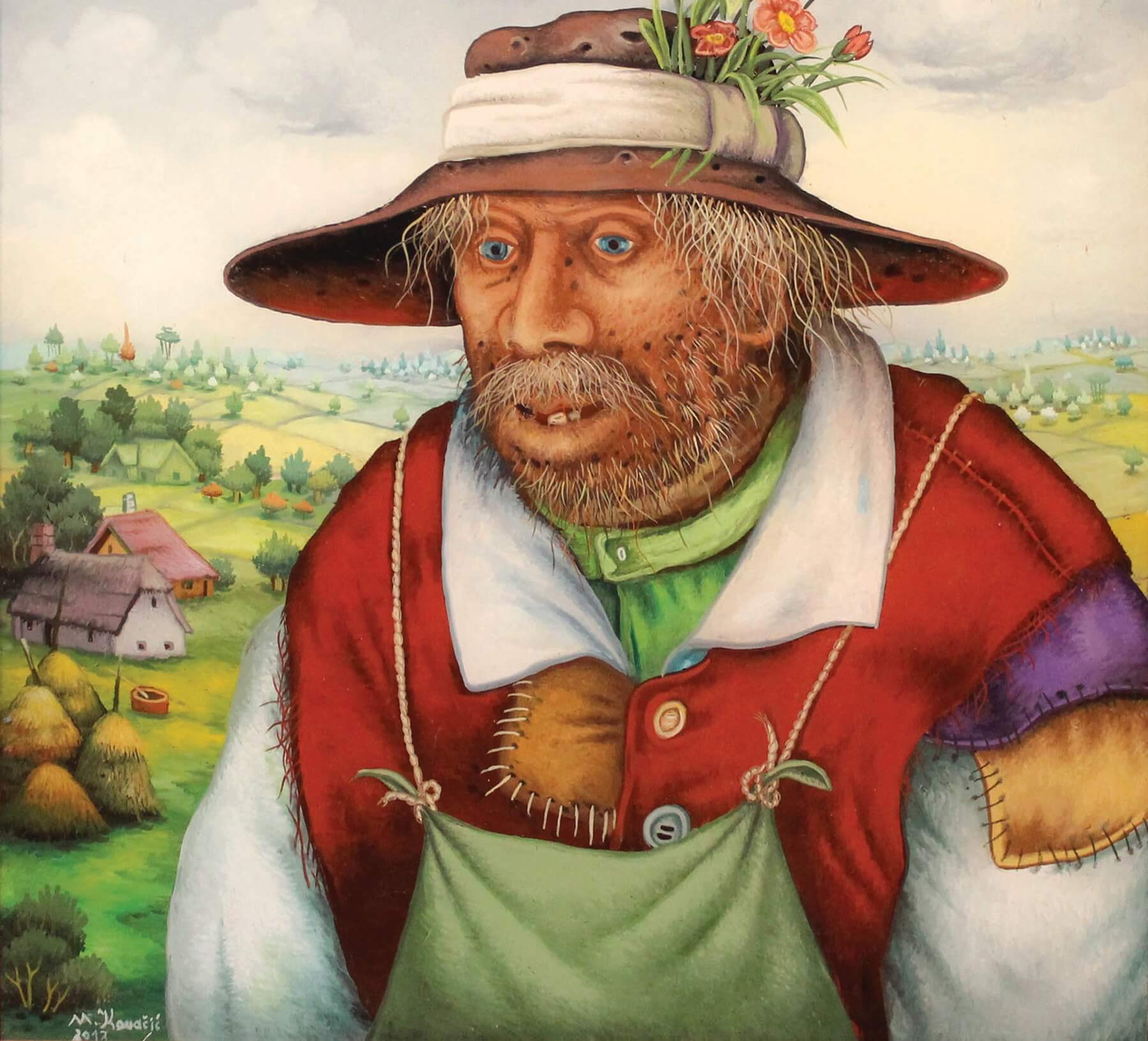 'Portrait' hanging at Galerija Mijo Kovačić © Koprivnica Town Museum
'Portrait' hanging at Galerija Mijo Kovačić © Koprivnica Town Museum
Galerija naivne umjetnosti (Gallery of Naive Art), Hlebine
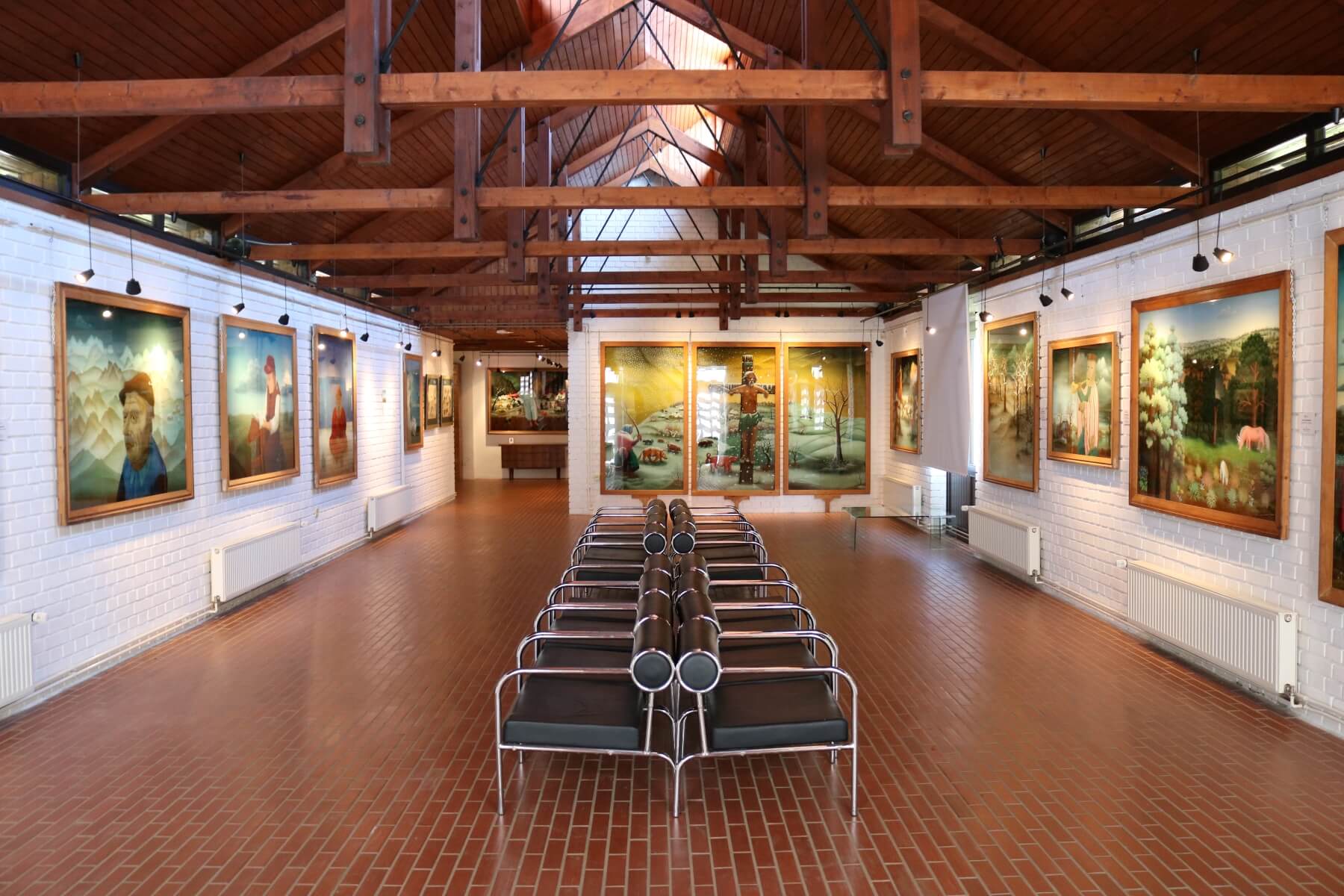
Founded in 1968, the Gallery of Naive Art in Hlebine is one of the top two most important galleries for Naïve Art in Croatia, the other being the Croatian Museum of Naïve Art in Zagreb. But, unlike their Zagreb counterpart, this gallery concentrates specifically on the Hlebine School and locally produced art. A crowd of sculpted wooden figures greets you on the front lawn. Inside, beneath the wooden beams of a beautiful building designed specifically for this purpose, some of the best artists and paintings of the Hlebine School.
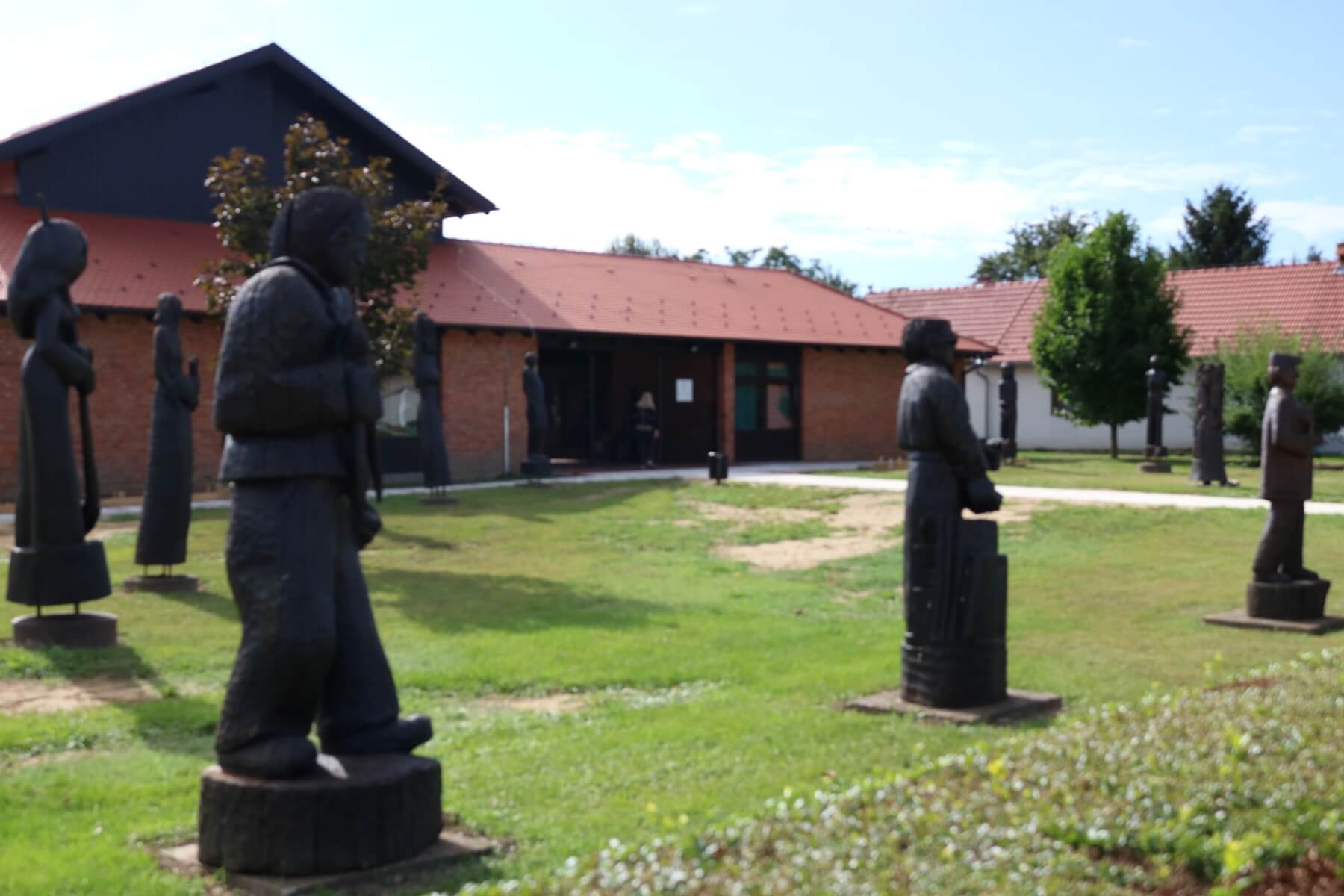
In the mid-1980s, when he was the most famous of all Croatian Naive Artists, neighbour Ivan Generalić paid the gallery a visit. He offered to pay for an extension to the gallery, on condition that it be used to house a permanent exhibition of his work. It was a win-win for the museum and Ivan Generalić subsequently donated some of his true masterpieces for the collection.
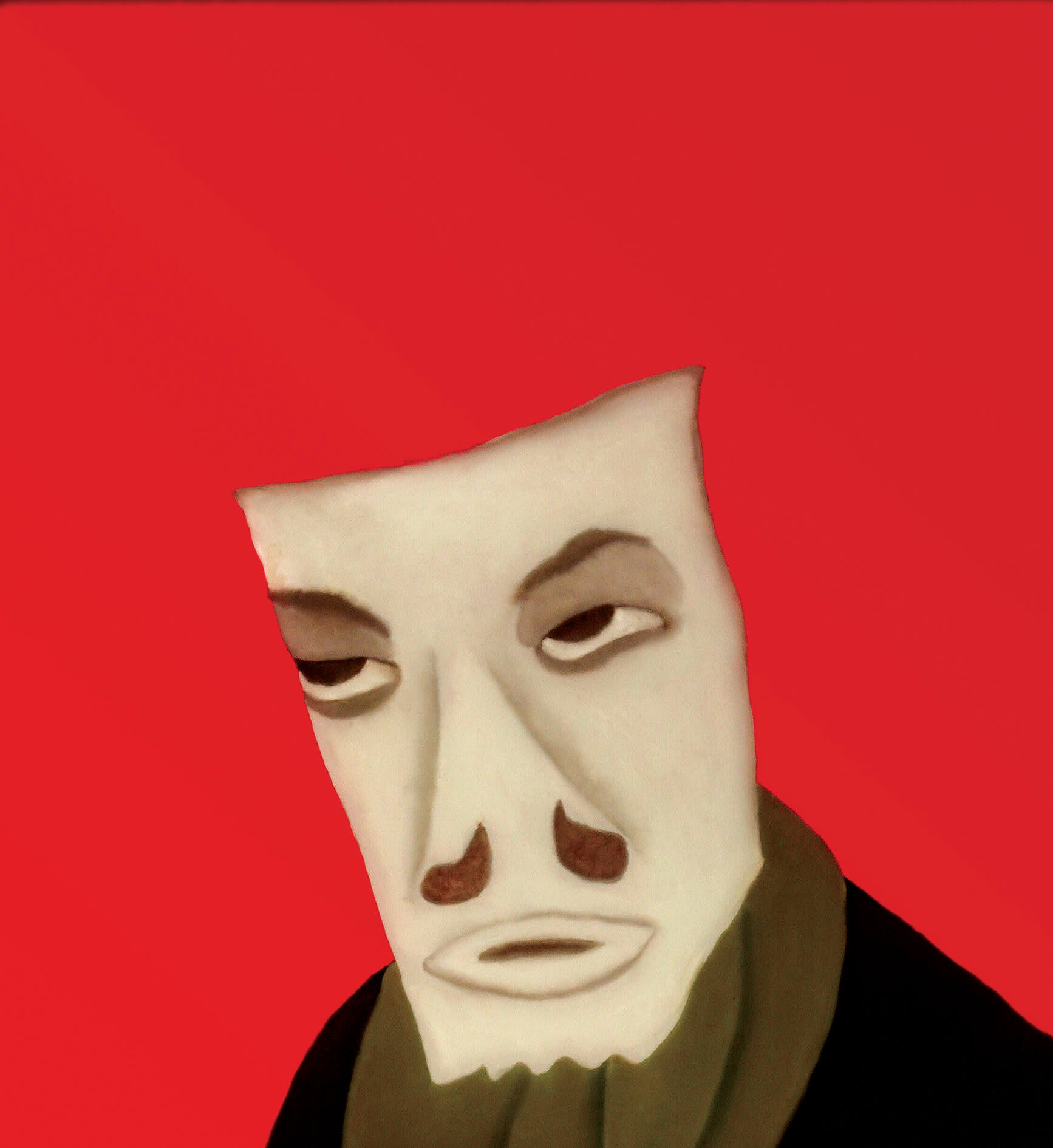
The newer part of the gallery is so true to the original design that, unless informed, you'd never guess it was built later. You'll find works by every key member of the Hlebine School here, including Ivan Generalić, Franjo Mraz and Mirko Virius, Josip Generalić, Ivan Večenaj, Ivan Lacković, Mijo Kovačić, Franjo Filipović and Dragan Gaži. Today, the museum is run by Koprivnica Town Museum. Find out more about the gallery here.
Galerija Josip Generalić, Hlebine
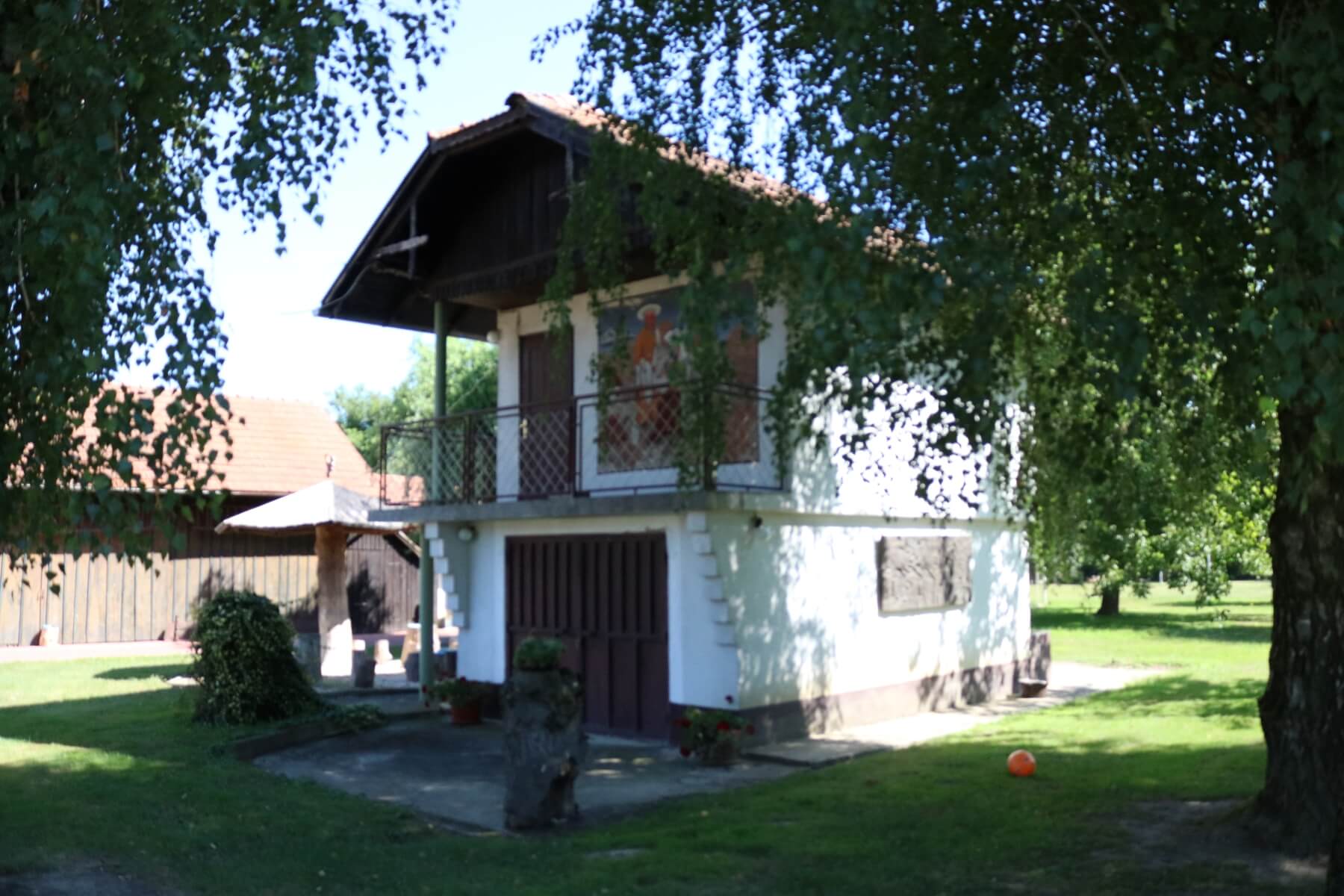
“How long have you got?” asks Ivan Generalić, grandson of Josip Generalić, great-grandson of Ivan Generalić, as he greets you at the Galerija Josip Generalić, Hlebine. He's asking if there's time for the1 hour tour or 6-hour tour. We think he's joking. He's not.
Generalić family have lived here for at least five generations. Having two of the Hlebine School's most famous and most successful painters within their ranks has allowed them to expand their property portfolio. It's just as well, because there's a lot to see here. What was once the simple, semi-agricultural farmstead where Ivan's great grandfather was born is now a sprawling family estate that houses an ethno-museum and considerable gallery spaces filled with incredible exhibits. All of the original furniture from how his great grandfather lived is preserved, displayed as it was, only in an adjoining property the family now own. Alongside the history and many works of Ivan Generalić and Josip Generalić, folk art, sculpture and artisan furniture made by incredible craftsmen from across the Balkans, who the painters once traded with.
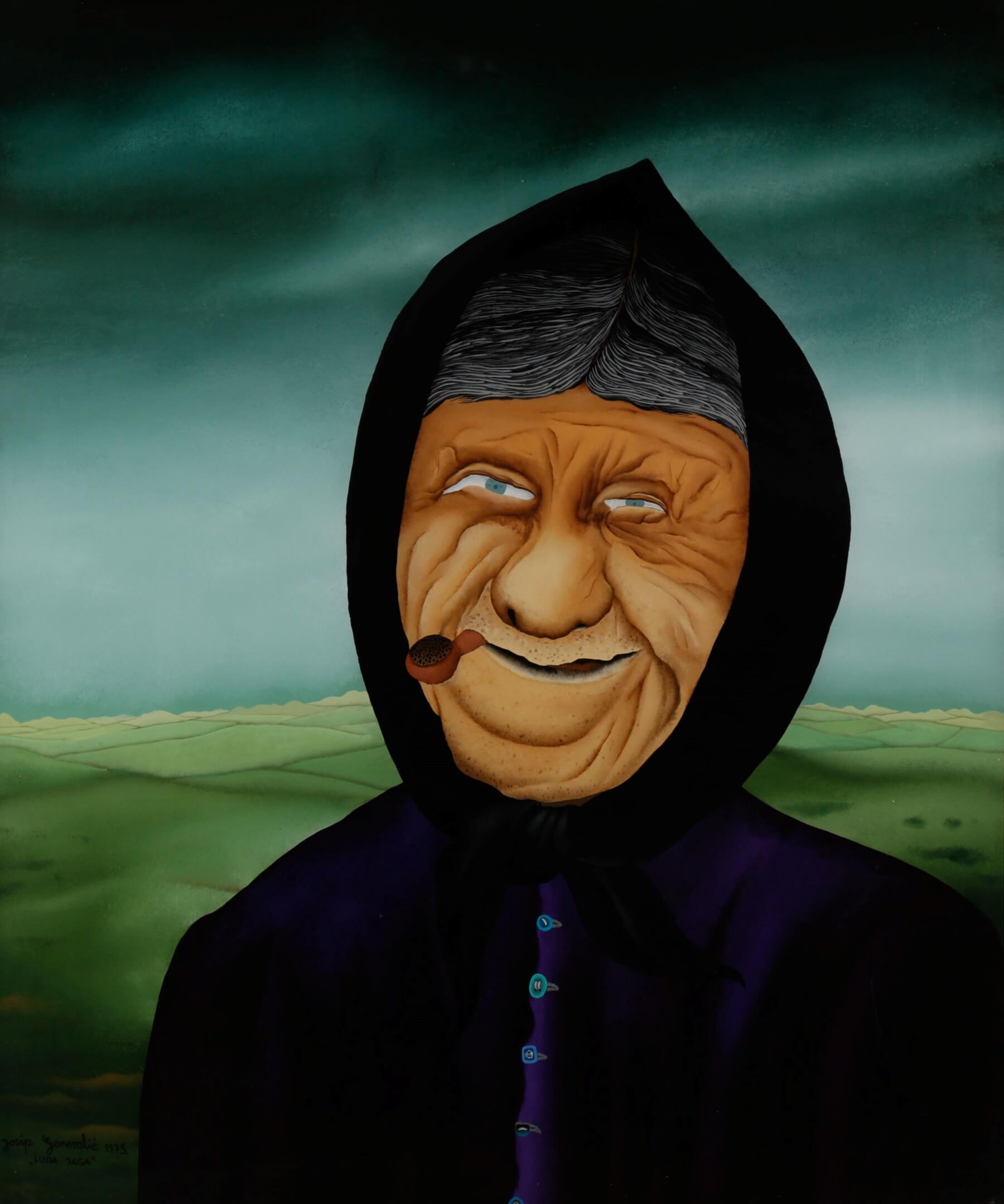 Luda Jaga by Josip Generalić, hanging at the Galerija naivne umjetnosti (Gallery of Naive Art), Hlebine © Koprivnica Town Museum
Luda Jaga by Josip Generalić, hanging at the Galerija naivne umjetnosti (Gallery of Naive Art), Hlebine © Koprivnica Town Museum
If you already like this kind of art, you might have to pinch yourself more than once that you're being shown around by someone called Ivan Generalić. Ivan himself is not only knowledgeable but extremely engaging - there are several big laughs on the tour. Ivan points out one image of an unloved neighbour, who grandfather Josip sent to the moon. He provides him with a Podravina cow so at least he can survive. Perhaps feeling slightly guilty, in the next room, Josip has painted the neighbour's return to earth. Although, he lands nearby in the famously barren Đurđevac desert (sometimes known as the Croatian Sahara). That's quite a lot of time and paint spent on someone you don't like!
Ivan's great grandfather also had a sense of humour. Having grown tired of friends bragging about their holidays in summer houses on the Croatian coast (which he did not like), at the height of his fame he decided to build his own. He invited several friends to accompany him on his holiday. And proceeded to take them to his own back garden, just metres from his main residence, where he had built the summer house. Genuinely, you'll wish you had time for the 6-hour tour. Find out more about the gallery here.
Galerija Ivan Večenaj, Gola
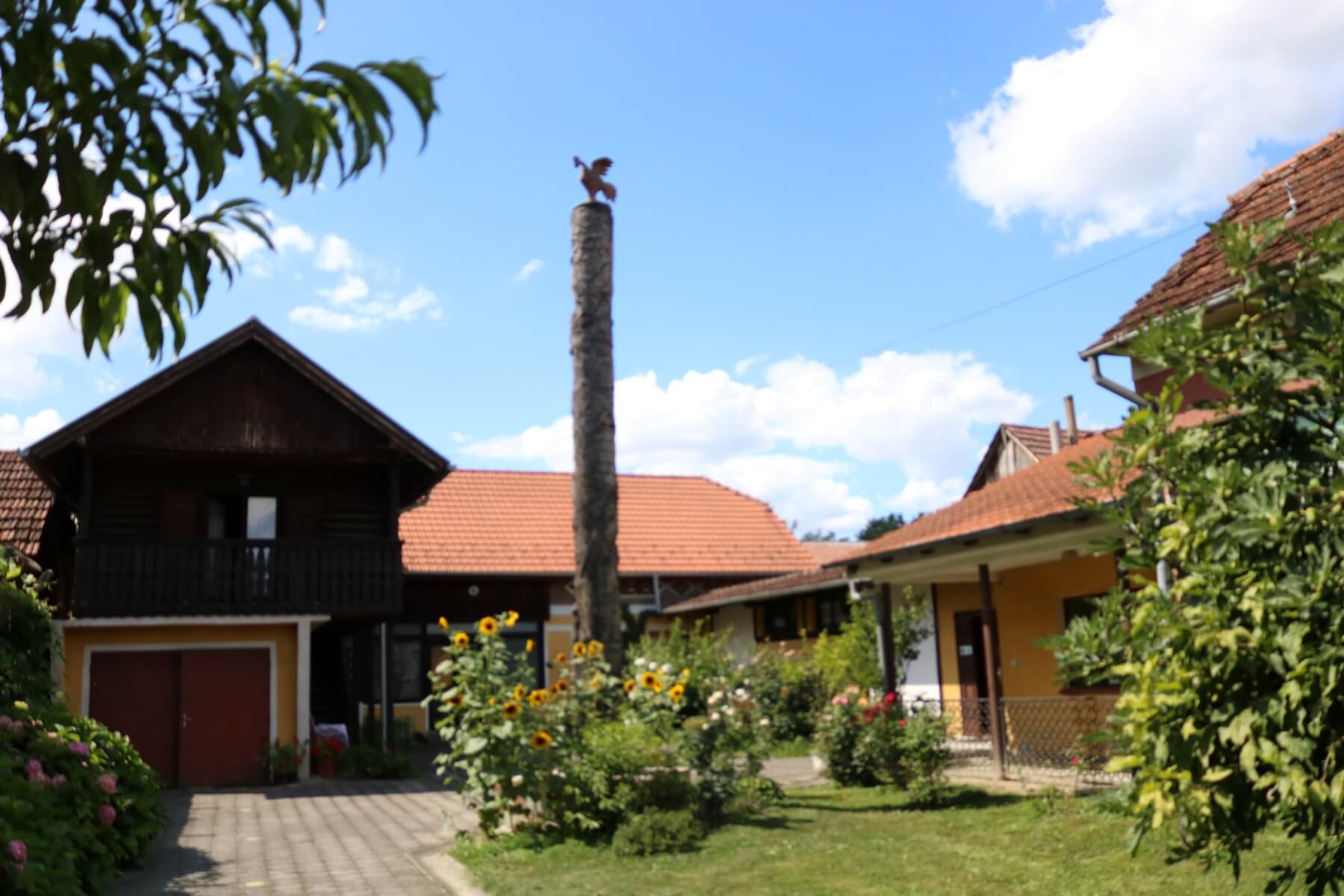
Some of the work by artists from the first and second generation of the Hlebine School are scattered far and wide. But, with the canon of Ivan Večenaj, it's a different story. Truly breathtaking examples of his finest work – definitely among the very best – were reserved by the artist for his family collection. Included in the collection, most of his key sacral works, including Golgotha, a triptych of the life of Jesus, crucifixion and the Four Horsemen of the Apocalypse. Don't worry, it's not all doom and gloom. Beautiful and bright images of Podravina roosters, agriculture and a charming portrait of his wife hang alongside. You can view them all at Večenaj's former home, now Galerija Ivan Večenaj in Gola. Across the road, an ethnic museum preserves life how it once was here. A truly unmissable highlight on the trail of Croatian Naive Art. Find out more about the gallery here.
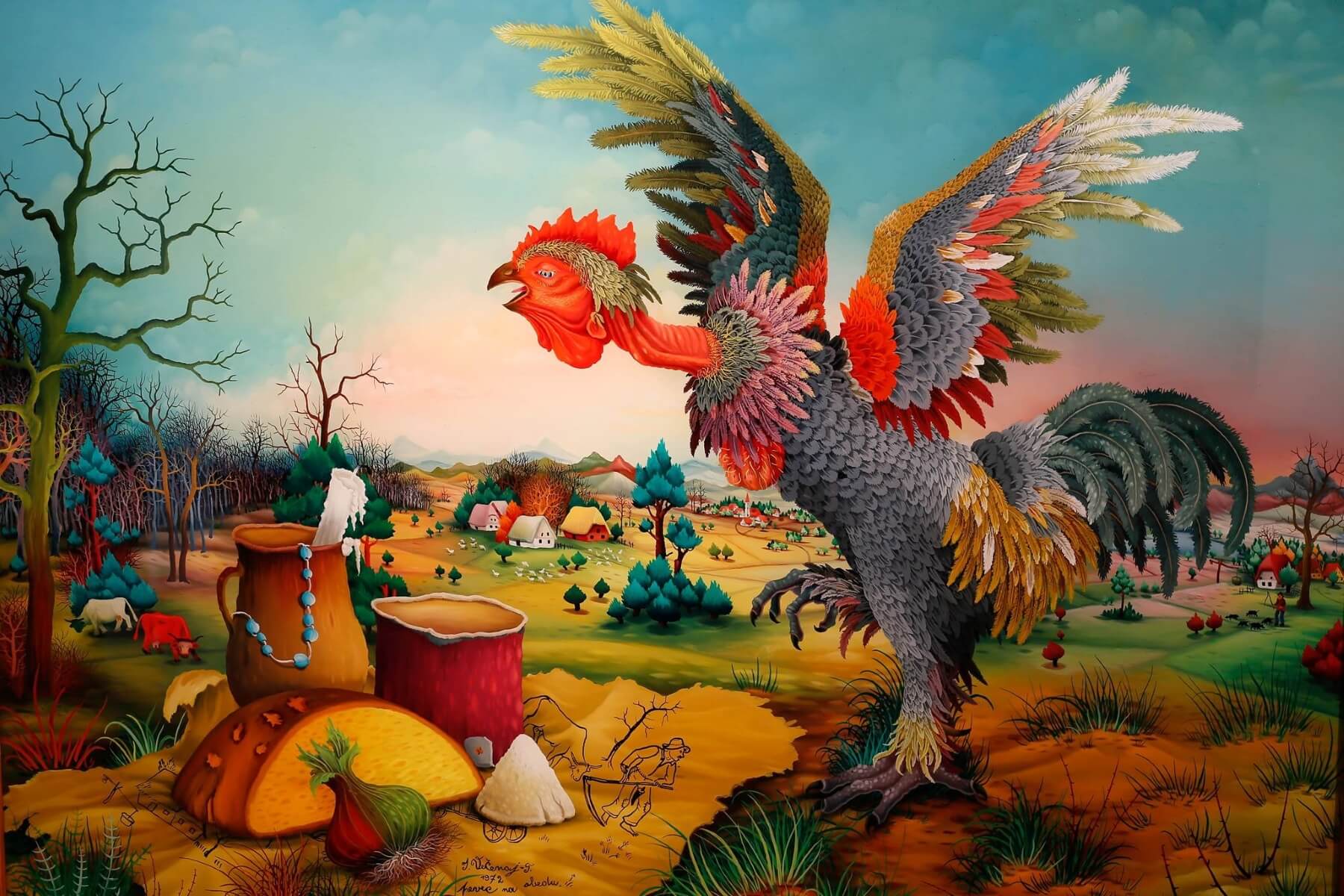 'Pevec na obedu' © Galerija Ivan Večenaj
'Pevec na obedu' © Galerija Ivan Večenaj
Galerija Ivan Lacković, Batinske
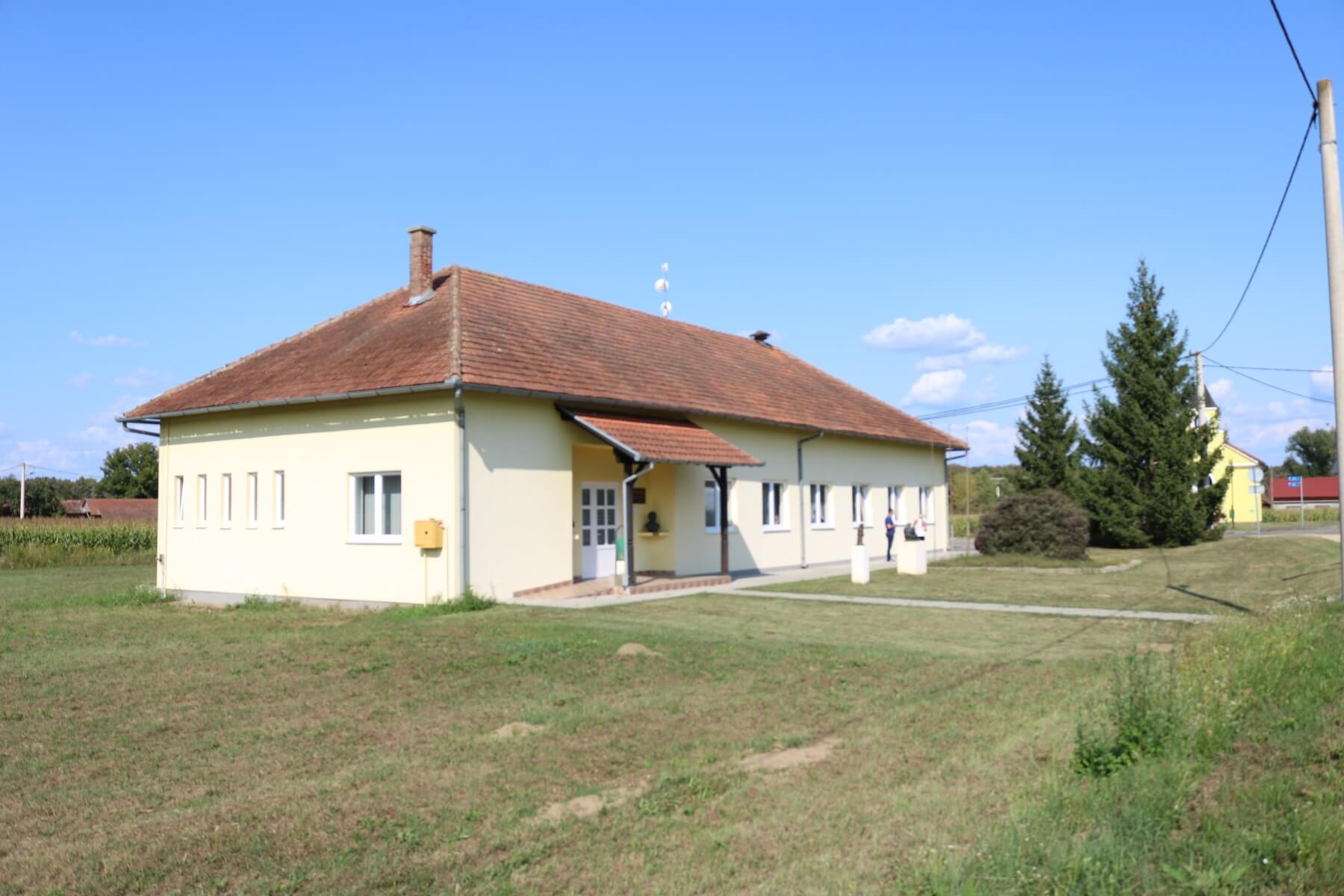
Clearly something of a local patriot, Ivan Lacković donated some 300 works to the village of his birth. Within the collection, you'll find not only works by Lacković himself but also sculptures by Naive Artists Ljubica Marulec and the painter's brother, M. Lacković. Find out more about the gallery here.
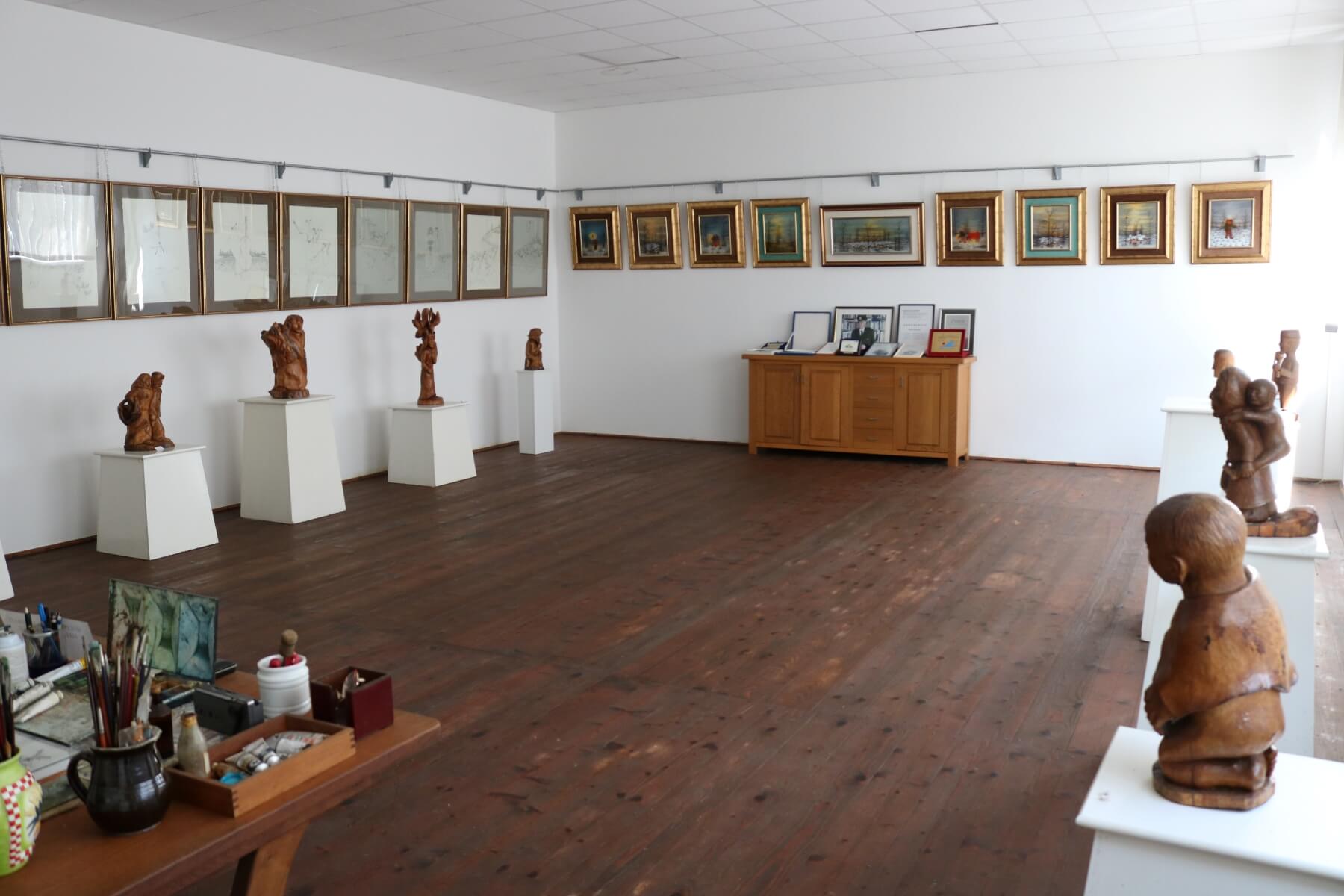
Podravina Motifs (Podravski motivi)
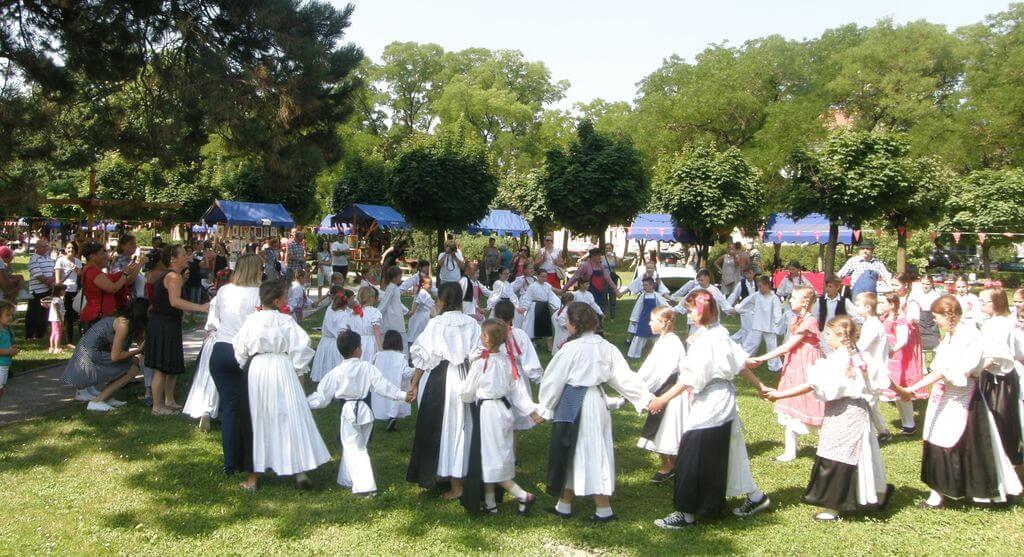 Podravina Motifs (Podravski motivi). Photo © Grad Koprivnica
Podravina Motifs (Podravski motivi). Photo © Grad Koprivnica
A three-decade-old Koprivnica event that showcases all of the cuisine, culture, music, dance, costume and art of Podravina. Naive Art is a key and central theme to the event. Usually, there are over 50 contemporary Naive Artists from the region exhibited, with their work on sale. Taking place each summer, it's a great place to get to know traditional Podravina and to pick up some amazing gifts. Find out more about the event here.
Šetnja kroz naivu u Hlebinama (Walk Through The Naive of Hlebine)
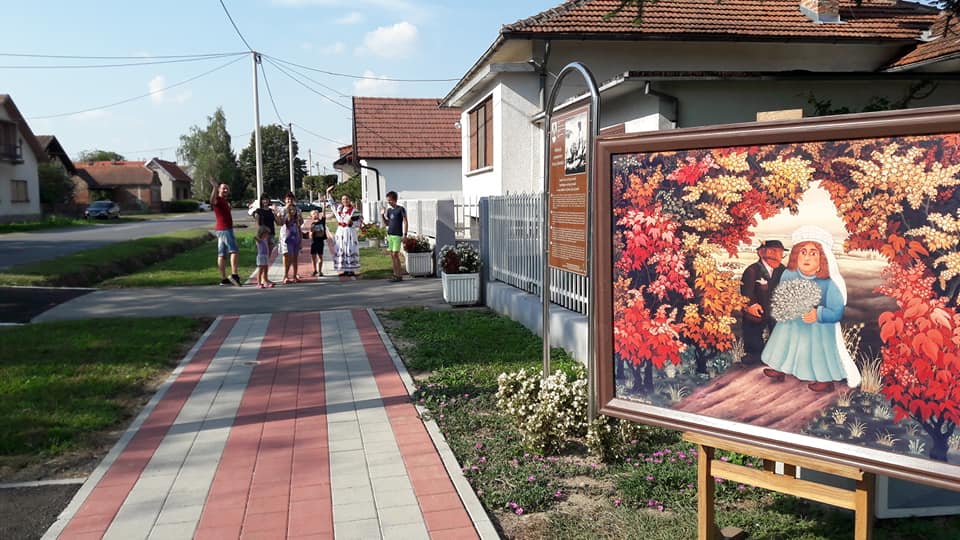 Outside Galerija Josip Generalić during Šetnja kroz naivu u Hlebinama © Tourist Board Central Podravina
Outside Galerija Josip Generalić during Šetnja kroz naivu u Hlebinama © Tourist Board Central Podravina
An annual open-air gallery of Hlebine Naive Art taking place on the streets of the village itself. Organised by Tihomir Želimorski who has the rural accommodation offer Stari zanati in Hlebine, Šetnja kroz naivu u Hlebinama differs from Podravina Motifs because it focusses exclusively on art – painting and sculpture. The houses in Hlebine are treasure troves of Croatian Naive Art. During this summertime event, all village residents bring their paintings and statues out onto the streets, hang them on trees or in gardens. You're invited to walk around the delightful village to look. Find out more about the event here.
This article was produced with the kind help of Koprivnica-Križevci County Tourist Board and checked for accuracy by Koprivnica Town Museum.
If you want to find out the latest from Podravina, be sure to check TCN pages here.


